Archive for the ‘Threats from Deforestation’ Category
Sunday, September 2nd, 2012
[The following article was written by Tigerquoll and initially published under the title ‘Anthology of State Serial Rape of Bermagui’s Spotted Gum Forest Habitat‘, on ^CanDoBetter.net 20100216]
 Click this image to play music
then click back to this article as it plays Click this image to play music
then click back to this article as it plays
.
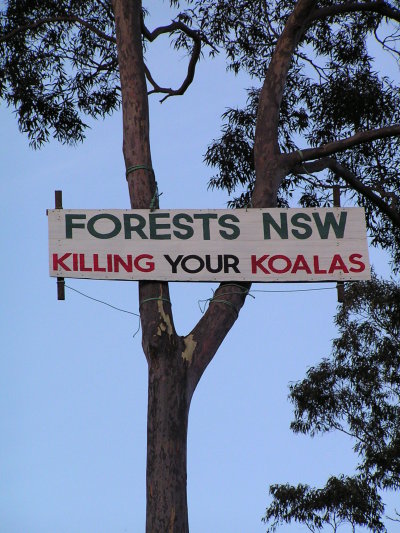 Nothing less than the Australian Government can be trusted to protect vital Koala Habitat.
Lesser smaller-minded state governments only see Koala Habitat as a logging and tourism resource.
Small minded politicians like Kristina Keneally can never be trusted with national treasures
Nothing less than the Australian Government can be trusted to protect vital Koala Habitat.
Lesser smaller-minded state governments only see Koala Habitat as a logging and tourism resource.
Small minded politicians like Kristina Keneally can never be trusted with national treasures
.
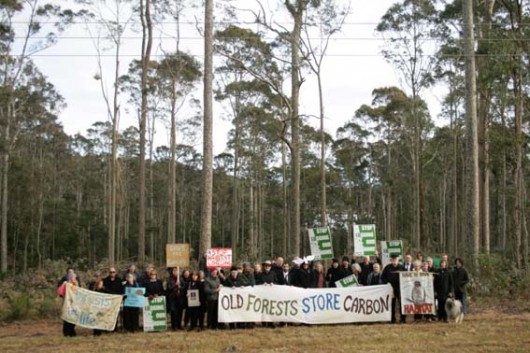 Bermagui’s Spotted Gums
..the local Narooma Community in their defence against ‘Forest NSW’ (the Forest-Fiddling loggers)
Bermagui’s Spotted Gums
..the local Narooma Community in their defence against ‘Forest NSW’ (the Forest-Fiddling loggers)
.
 Forest-Fiddling Logger driving his Spotted Gum spoils truck
Forest-Fiddling Logger driving his Spotted Gum spoils truck
.
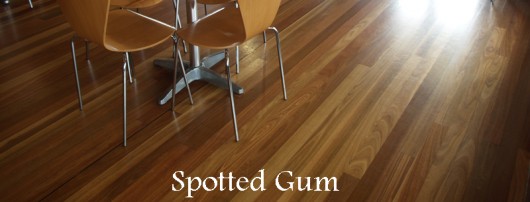 But Eucalyptus maculata is a tree, not a floor But Eucalyptus maculata is a tree, not a floor
.
In terms of Australia’s iconic ‘Spotted Gum’, the word “spotted” refers to the soft mottled colour caused by weathering of the outer tree as it sheds elliptical strips of bark.
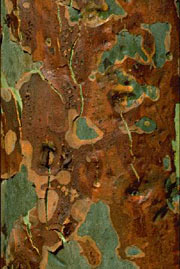 Spotted Gum bark Spotted Gum bark
.
This colour varies from pale greybrowns and soft creams to a rich chocolate brown. A very tough timber, its frequent wavy grain can produce an attractive and highly valued fiddleback effect. [Source: Boral website, ^http://www.boral.com.au/timberflooring/timber_species_-_spotted_gum.asp]
.
 Build something great, but don’t destroy something great in the process
– like Koala Spotted Gum Forests!
Invest in Boral and you invest in Koala extinction
Build something great, but don’t destroy something great in the process
– like Koala Spotted Gum Forests!
Invest in Boral and you invest in Koala extinction
.
About 380km south of Sydney lies what NSW Tourism labels the beautiful ‘Sapphire Coast’ with the popular seaside town of Bermagui.
Less than 3km north of Bermagui heading north along Bermagui-Cobargo Road and up the Bermagui River estuary is the Bermagui State Forest – a label by the NSW Department of Primary Industry (DPI) given to magnificent Spotted Gum forest.
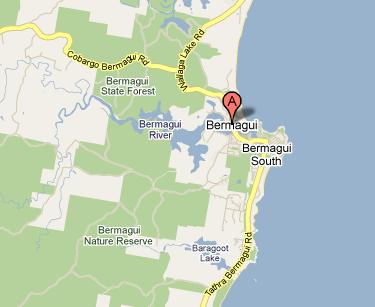 . .
This forest is vital habitat for threatened native fauna – the Yellow Bellied Gliders, Grey-Headed Flying Foxes, Tiger Quolls, Sooty Owls, Sea Eagles, Possums and Australia’s iconic Koala.
.
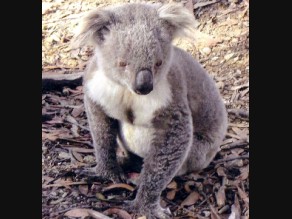 Koala in Bermagui’s Spotted Gum forest – a displaced landlord
Koala in Bermagui’s Spotted Gum forest – a displaced landlord
.
Australia’s iconic ‘Spotted Gums’
.
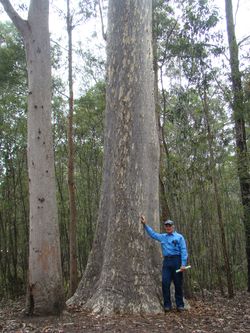 A mature iconic Spotted Gum Tree
About 400 years old, about 30 metres high
A mature iconic Spotted Gum Tree
About 400 years old, about 30 metres high
[Source: ‘A gum tree that saw Captain Cook and before’, ABC Radion interview of John Knight by Ian Campbell, 20100119,
Listen to Interview: ^http://blogs.abc.net.au/nsw/2010/01/a-gum-tree-that-saw-captain-cook-and-before.html]
.
Australia’s magnificent and unique Spotted Gums are naturally distributed in open forests along the hilly coastal corridor from south-east Queensland down through New South Wales and with a few isolated pockets in East Gippsland, Victoria. They belong to the botanical family ‘Myrtaceae’ and grow straight and tall up to 40 metres. Their height attracts roosting by Sea Eagles.
 Note the planet’s sole natural distribution of Spotted Gum Forests
They have become the target of corporate development simply because Spotted Gums prefer a mild temperate climate near the coast
..like Australia’s millions of breeding humans, and profiteering corporate developers
Note the planet’s sole natural distribution of Spotted Gum Forests
They have become the target of corporate development simply because Spotted Gums prefer a mild temperate climate near the coast
..like Australia’s millions of breeding humans, and profiteering corporate developers
.
Spotted gums flower once every two years and produce a rich pollen that attracts native birds such as Lorikeets and Yellow Tailed Cockatoos as wells as possums and flying foxes including the IUCN vulnerable listed Grey-Headed Flying Fox. [Source: Australian Native Plants Society, Corymbia maculata, ^http://asgap.org.au/c-mac.html]
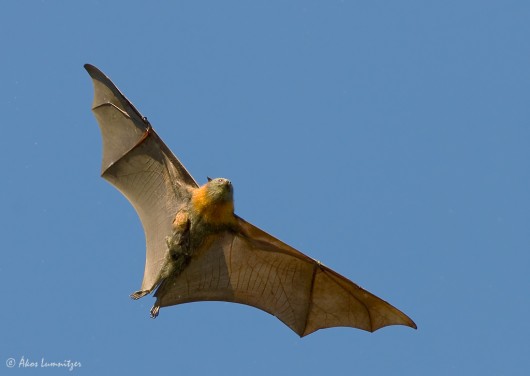 Grey-Headed Flying Fox (Pteropus poliocephalus)
The grey-headed flying-fox is listed as vulnerable to extinction under NSW and Australian legislation because of declining numbers and key threats such as habitat loss and urban conflict. Records indicate that grey-headed flying-foxes may once have numbered in the millions, but are now reduced to as few as 400,000. In the decade before listing, their population was estimated to have declined by 30%.
(Photo by Ákos Lumnitzer, ^http://amatteroflight.com/) Grey-Headed Flying Fox (Pteropus poliocephalus)
The grey-headed flying-fox is listed as vulnerable to extinction under NSW and Australian legislation because of declining numbers and key threats such as habitat loss and urban conflict. Records indicate that grey-headed flying-foxes may once have numbered in the millions, but are now reduced to as few as 400,000. In the decade before listing, their population was estimated to have declined by 30%.
(Photo by Ákos Lumnitzer, ^http://amatteroflight.com/)
.
Unlike the declaration of a ‘National Park’ which affords federal environmental protection to forest habitat, the State label of a ‘State Forest’ is a misnomer. A ‘State Forest’ is deemed a timber and woodchip resource for logging. The same public relations label is used across New South Wales, ACT, Victoria, Western Australia, Tasmania and Queensland. A State Forest is not treated as a forest for its natural habitat values, but rather as a logging coup on death row, that can be chainsawed at will anytime. Perhaps ‘Death Row Forest’ is a more apt label than speaking the State euphemism of ‘State Forests’.
And its public relations label logging as ‘harvesting’, a euphemism to belie the destructive reality.
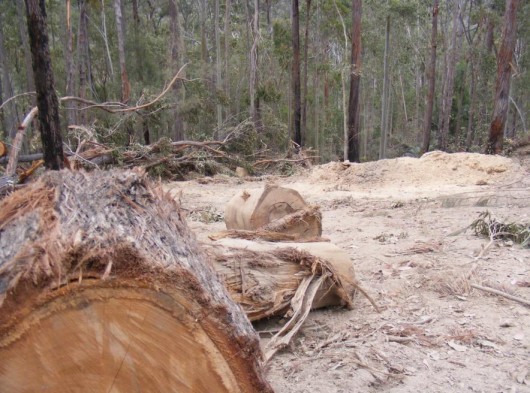 Bermagui State Forest after the loggers Bermagui State Forest after the loggers
.
The NSW Logging Offensive of 1988
.
On the back of a century of clear felling Bermagui State Forest was logged in the late 1980s. Then according to data from the ‘Bureau of Resource Science‘ (aka science graduates on the payroll of loggers), 148ha were “thinned” in 1996, and another 133ha that same year, then 94ha in 1999.
Typically 70% of the spotted gums goes to Boral’s mills in Narooma, Nowra and Batemans Bay as sawlogs to be processed into mainly flooring. The remainder end up as woodchips at Nippon Paper’s woodchip mill at Twofold Bay for export to Japan.
So Australia’s precious endangered habitat is being destroyed for house flooring and office paper. .
.
The NSW Logging Offensive of 2008
.
In October 2008, NSW Forests logged what it labeled “two compartments” in Bermagui State Forest north of Bermagui. It justified this under the infamous Eden Regional Forest Agreement (RFA). [>Read Agreement] [Source: ^http://www.daff.gov.au/__data/assets/pdf_file/0009/51021/nsw_rfa_eden.pdf]
This RFA is one of three established in 1999, in which the NSW Government relegated 15.1 million hectares of native forests across New South Wales for logging anytime. The usual public relations spin preceded the logging. Southern Region manager of Forests NSW, Ian Barnes.
It was at this time that Labor’s Minister for Primary Industries (Forests NSW) Ian MacDonald and Labor’s Minister for Police Tony Kelly started to use Dick Cheney tactics to push their weight around with protesters. The following questions to the NSW Legislative Council by NSW Greens Senator Lee Rhiannon on 28th October 2008, highlight the escalated use of law enforcement into a heavy handed riot squad:
.
Lee Rhiannon MLC:
“I direct my question to the Minister for Police. Did officers stationed at Batemans Bay police station in collaboration with Forests New South Wales hold a meeting at the Bermagui Country Club in September to warn locals associated with calling for forest protection not to protest when logging commenced in the Bermagui State Forest? Does the holding of this meeting reflect that Batemans Bay police officers have adopted a zero tolerance policing approach to forest protesters? Considering that since logging started in Bermagui State Forest on 27 October with a group of about 40 protesters gathered in the vicinity, about 15 police cars, more than 20 police, including members of the Public Order and Riot Squad, a mobile police command bus and two police rescue vans have been in attendance, will this level of policing continue for the coming six weeks of logging in this area? What is the anticipated cost of this operation?
.
Tony Kelly MLC (response):
“The Far South Coast Local Area Command of the New South Wales Police Force has been advised that New South Wales Forests is to commence logging compartments of Bermagui State Forest later this month. As in the past, protests are expected. As always, the New South Wales Police Force is committed to maintaining public order. For this reason, local police and various commands, including the Public Order and Riot Squad, Highway Patrol and Rescue Squad will join together to conduct an operation.
This operation will focus on ensuring the protection of persons engaged in lawful activities. Local police have made it clear that anyone engaging in unlawful or dangerous activity in or near the logging operation will have action taken against them. When offences continue and are considered dangerous, police will arrest and charge people as necessary. Police respect people’s rights to protest during these times; in no way are they looking to prevent lawful and peaceful protests. Police have asked anyone who intends to protest to contact them so that they can attempt to facilitate lawful activity, minimise disruption and focus on protecting the safety of everyone involved.”
.
[SOURCE: ‘Bermagui State Forest Logging Protests‘, Question raised NSW Legislative Council by The Greens Senator Lee Rhiannon, Parliament of New South Wales, Hansard, 20081028, ^http://www.parliament.nsw.gov.au/prod/parlment/hanstrans.nsf/V3ByKey/LC, 20081028, >Read Hansard Extract – go to page 10631, PDF, 344kb ]
.
The NSW Logging Offensive of Feb 2009
.
On Monday 2nd February 2009, logging operations resumed in the Bermagui State Forest after the summer holiday break period and continued for about two months.
Bruce Mathie and Sons is one of the prominent loggers in the area, but most timber finds its way either as saw logs to Boral for Spotted Gum flooring or else to Nippon Papers woodchip mill at Twofold Bay, Eden for export to Japan.
The forest eco-rapers ‘Forests NSW’ – bulldozed, chainsawed, logged, then left with their booty.
.
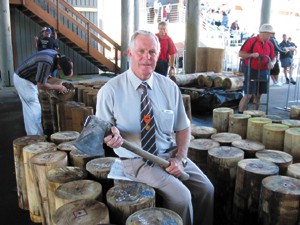 Kevin Mathie – 4th generation logger Kevin Mathie – 4th generation logger
.
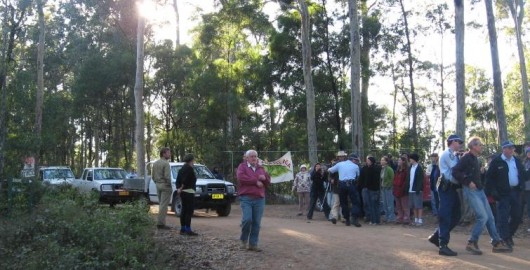 Logging contractor, Gil Mathie, in the middle of the picture at front (pink jumper)
More notably, this editor is saddened by bearing witness to a senior member
of the Bermagui community being arrested for conserving Spotted Gums and Koalas.
We love, we defend, we act for love.
Salute the man being arrested.
[Source: Local environmentalist, John Perkins, Gulaga Protest near Tilba on the NSW South Coast, 20070514]
Logging contractor, Gil Mathie, in the middle of the picture at front (pink jumper)
More notably, this editor is saddened by bearing witness to a senior member
of the Bermagui community being arrested for conserving Spotted Gums and Koalas.
We love, we defend, we act for love.
Salute the man being arrested.
[Source: Local environmentalist, John Perkins, Gulaga Protest near Tilba on the NSW South Coast, 20070514]
.
Labor’s Ian MacDonald’s Forestry Regulation of 2009
.
But rather that do the right thing by the Environment and by the Community and obey the law of the land, those in power The Labor Government’s (Forests NSW) forced changes to the law of the land to bloody well suit themselves. Arguably reminiscent of England’s King Henry VIII changing laws to accommodate his adultery, or Joh Bjelke-Petersen’s gerrymandering that secured his electoral hold on power.
In order to keep the cameras and local conservationist away from the loggers destructive practices, Forests NSW got the Minister to legislate an exclusion area around its logging with the public relations labeling of “mainly for safety reasons”.
On 1 September 2009, the NSW Forestry Regulation 2009 came into force making it illegal for anyone to trespass into areas marked by NSW Forests for logging. This has given Forests NSW absolute logging power with the police as its enforcement lackies.
Forests NSW Minister for Primary Industries, Ian MacDonald, tabled the Bill and it became law preventing democratic protests by people trying to save important habitat from destruction. It has given loggers free reign to log State Forests with impunity.
Under Part 3, Division 1, Clause 11 of this Regulation, a logger has legal authority to request anyone to leave a forestry area and this includes if that person “causes inconvenience.”
Under Clause 12, a logger can forcible remove anyone from a forestry area “who is causing annoyance or inconvenience.”
Surely such removal by a logger can be construed an assault under the Crimes Act? It is draconian. It is certainly an assault on Australians’ democratic right to protest. What was Ian MacDonald thinking?
.
Labor’s Ministers in charge three years hence…
.
 Labor’s Police Minister Tony Kelly MLC
NSW Minister for Emergency Services, Lands, Police and Primary Industries.
Labor’s Police Minister Tony Kelly MLC
NSW Minister for Emergency Services, Lands, Police and Primary Industries.
.
‘Tony Kelly was targeted by protesters as he arrived to give evidence at the ICAC in June. Today the commission has found the former minister engaged in corrupt conduct.’
[Source: Protesters target Kelly outside ICAC’, by Dean Lewins, AAP, 20111212, ^http://www.abc.net.au/news/2011-12-12/protesters-target-kelly-outside-icac/3725744]
.
‘DISGRACED former state Labor ministers Tony Kelly and Ian Macdonald are demanding taxpayers foot their legal bills and the state government could be forced to hand over up to $250,000. Despite being found by corruption watchdog ICAC to have forged official documents while a minister, Mr Kelly has formally asked the O’Farrell government to cover the cost of his elite legal team.’
[Source: ‘Disgraced former Labor ministers Tony Kelly and Ian Macdonald demand taxpayers foot their bills’, by Barclay Crawford, Daily Telegraph, 20120101, ^http://www.dailytelegraph.com.au/news/disgraced-former-labor-ministers-tony-kelly-and-ian-macdonald-demand-taxpayers-foot-their-bills/story-e6freuy9-1226234077573].
.
 Labor’s Logging Minister Ian MacDonald MLC
Forests NSW/ Minister for Primary Industries in 2009 Labor’s Logging Minister Ian MacDonald MLC
Forests NSW/ Minister for Primary Industries in 2009
.
‘The disgraced former NSW resources minister Ian Macdonald is to face a new corruption inquiry into the granting of coal exploration licences. The Independent Commission Against Corruption said in a statement yesterday that Mr Macdonald is being investigated for allegedly using his ministerial position ”to advantage the private interests of others”.
[Source: ‘ICAC to examine mining licences‘, by Kate McClymont, Senior Reporter, Sydney Morning Herald, 20120524, ^http://www.smh.com.au/nsw/icac-to-examine-mining-licences-20120523-1z5ov.html‘]
.
‘The senior state minister Ian Macdonald signed taxpayers up to the V8 Supercars race without a system to manage potential conflicts of interest, without advice from the government’s major events body and without a proper business case, the NSW Auditor-General finds.’
[Source: ‘Mate’s race: $45m deal snares MP‘, by Anne Davies, Linton Besser and Nick O’Malley, 20100529, ^http://www.smh.com.au/nsw/mates-race-45m-deal-snares-mp-20100528-wldb.html]
.
The NSW Logging Offensive of Sep 2009
.
In September 2009, Forests NSW commenced logging again in Bermagui State Forest, like pack rapists marauding through a maternity ward.
Sure enough, on Monday, 14th September 2009, Police arrested two of four forest campaigners who had allegedly entered Bermagui State Forest in what Forests NSW had labeled logging compartments 2001 and 2002. Apparenpe known to support koalas is unacceptable, particularly when the NSW government cannot prove their claims that koalas can be found anywhere in the south east,” said Robert Bertram, local Friends of Five Forests member.
“This is yet another example of Forests NSW lack of care for community and the environment,” said Lisa Stone, spokesperson for South East Forest Rescue.
“They are logging old-growth in Dampier, threatened species habitat in South Brooman, endangered species habitat in Nadgee and now this.”
“The loss of biodiversity coupled with logging and burning means the condition of many forests is as bad as the endangered ecological communities on private land, unable to support most threatened and endangered species and unable to recover.”
“We urge the newly appointed Minister for the Environment, Mr John Robertson, to step in on behalf of the native forests and their dependents and stop these archaic practices.”
“The current government policy of destroying habitat to satisfy ‘wood supply agreements’ is robbing from the future generations their chance of survival. The amount of breaches was astounding and shows that Forests NSW cannot be trusted to log these important areas of Koala habitat.”
“We have inspected many other logging operations in the past year and have found the same breaches everywhere we have looked. This is pe known to support koalas is unacceptable, particularly when the NSW government cannot prove their claims that koalas can be found anywhere in the south east,” said Robert Bertram, local Friends of Five Forests member.
“This is yet another example of Forests NSW lack of care for community and the environment,” said Lisa Stone, spokesperson for South East Forest Rescue.
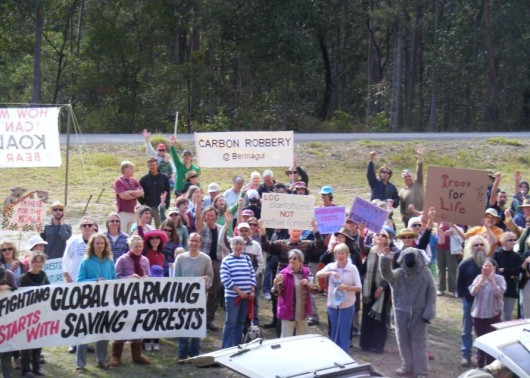 A community morally right to defend habitat and prepared to defend that right A community morally right to defend habitat and prepared to defend that right
.
“They are logging old-growth in Dampier, threatened species habitat in South Brooman, endangered species habitat in Nadgee and now this.”
“The loss of biodiversity coupled with logging and burning means the condition of many forests is as bad as the endangered ecological communities on private land, unable to support most threatened and endangered species and unable to recover.”
“We urge the newly appointed Minister for the Environment, Mr John Robertson, to step in on behalf of the native forests and their dependents and stop these archaic practices.”
“The current government policy of destroying habitat to satisfy ‘wood supply agreements’ is robbing from the future generations their chance of survival. The amount of breaches was astounding and shows that Forests NSW cannot be trusted to log these important areas of Koala habitat.”
“We have inspected many other logging operations in the past year and have found the same breaches everywhere we have looked. This is not a once off mistake but a systemic disgust for any environmental protection measures.”
Conservationists state the native forest logging industry is unsustainable and only propped up by political will, public subsidies and union backing.
Spokesperson for the South East Region Conservation Alliance, Pru Acton, says:
“The significant social and economic costs of reduced biodiversity can only increase while our natural systems are poorly managed.”
“Credible experts agree that the cost of logging this habitat is not only the last few koalas, but also potable water supplies, oysters, the inspiration for the local artists community, and another chunk of the Wilderness Coast’s tourism potential.”
“It seems the NSW Government has now decided its contractual obligations to supply sawlogs locally and woodchips to Asia is more important then protecting this much loved native animal.”
.
South East Region Conservation Alliance
.
Conservationists state the native forest logging industry is unsustainable and only propped up by political will, public subsidies and union backing.
Spokesperson for the South East Region Conservation Alliance, Pru Acton, says: “The significant social and economic costs of reduced biodiversity can only increase while our natural systems are poorly managed.”
“Credible experts agree that the cost of logging this habitat is not only the last few koalas, but also potable water supplies, oysters, the inspiration for the local artists community, and another chunk of the Wilderness Coast’s tourism potential.”
“It seems the NSW Government has now decided its contractual obligations to supply sawlogs locally and woodchips to Asia is more important then protecting this much loved native animal.”
.
[Source: ‘Logging resumes at Bermagui’, by Stan Gorton Narooma News, 20090204 – note the Narooma News has removed this news item online. However, the Narooma News has chosen not to remove its following story (Source: ^http://www.naroomanewsonline.com.au/story/191381/albino-possum-causes-log-truck-roll-over-at-narooma/ if it be not similarly removed].
 Speeding logging trucker blames possum
..Narooma News editor’s reputation shot Speeding logging trucker blames possum
..Narooma News editor’s reputation shot
.
Narooma News spins the following story to appease local logger readership:
.
“In a bizarre set of circumstances, a rare but dead albino possum is believed to have caused a log truck roll-over on the Princes Highway just south of Narooma.
The accident occurred just after 1pm when witnesses said a local from Wallaga Lake stopped to look at the road-kill possum that had been lying on the roadside at the entrance to the Island View Beach Resort.
A series of cars backed up behind the stopped vehicle in the southbound lane. Another Narooma local who was last in the line of stopped cars looked in his rear-vision mirror only to see the huge red-coloured truck coming up fast from behind.
“I think I am going to buy a lottery ticket,” said the local, who at one point thought the truck was going to smash into him and end his life.
The truck driver then allegedly swerved onto the wrong side of the road, narrowly missing the line of cars and while he was fortunate not to face any oncoming northbound traffic, he did lose control on the straight stretch of highway.
The truck reportedly clipped a boat trailer, flipped onto its side, sliding down the highway with the prime mover coming to rest in bushland just off the verge north of the Nangudga Bridge.
An ACT couple who among those first on the scene were able to help the truck driver out of the cab but they said he was badly shaken up and was not aware of where he was.
The Pambula man was the only person injured in the accident and was taken to Moruya Hospital for treatment.
The highway was closed down to one lane with firefighters, police and RMS personnel cleaned up and investigated the scene.
Residents from the nearby Island View caravan park were alerted to the accident by a loud bang and they lined the highway watching the accident.
The accident occurred at the start of the June long weekend where NSW police were out in force urging drivers to be careful on the busy roads.
Albino or golden brush-tailed possums are very rare but there is a known population living in the Narooma area.’
.
~ by the Narooma News editor…and watch out for drop bears too!
.
Meanwhile NSW Forests remains culturally contemptuous to NSW forests
.
Forests NSW recruit their students with Communications degrees to lie for it on its website:
“State forests in NSW are managed sustainably to provide a supply of timber today and into the future, to protect the environmental values of the forest and provide community amenities.”
Forests NSW website claims that “Ecologically sustainable forest management (ESFM) is our guiding philosophy. ESFM is about managing forests to maintain ecological principles and biodiversity while optimising the benefits to the community from all uses of the forest…”
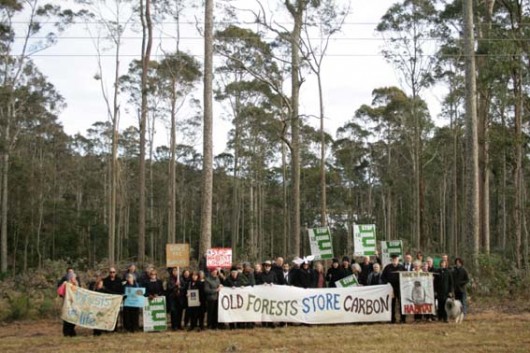 Narooma Community in defence of Koala Habitat
– clearly not convinced about Forests NSW spiel about “optimising the benefits to the community” Narooma Community in defence of Koala Habitat
– clearly not convinced about Forests NSW spiel about “optimising the benefits to the community”
.
Revolving Door politics of NSW Labor
.
In the revolving door politics of NSW Labor, Premier #3 Nathan Rees on 16th November 2009 sacked Ian MacDonald from his DPI Ministry.
Rees was himself sacked as premier on 3 December, then a week later, Labor Premier #4 Kristina Keneally (Labor show pony) reappointed Ian MacDonald ‘Minister for State & Regional Development and Minister for Mineral & Forest Resources‘ in December 2009.
The labelling of Minister for ‘Forest Resources’ left NSW State Forests in no doubt about the death row status. Throughout NSW Labor’s factional power shuffle Macca’s chair never got cold.
The then Minister for Primary Industries , Tony Kelly, overseeing Forests NSW, claimed on 18 November 2009: “The NSW Government has a solid track-record for maintaining prosperous and sustainable primary industries, I will be working hard with industry to ensure this tradition continues.”
.
[Source: Source: NSW Department of Primary Industries, ^http://www.dpi.nsw.gov.au/__data/assets/pdf_file/0019/308251/Minister-Kelly-Visits-Industry-and-Investment-NSW-Headquarters.pdf, since deleted by the NSW Government – the file, not the department unfortunately]
.
Tigerquoll’s Position
.
All State Forests should be added to Australia’a National Park Estate. State Governments and their narrow mindset culture cannot be trusted with ecology. Boral and Nippon Paper can transition their logging operations into plantation-only FSC resources.
The Twofold Bay Woodchip Mill was set up near Eden in 1969 by Daishowa Paper Manufacturing Company has exported and profitted from over 35 million tonnes of Australian native forest woodchips, mostly to Japan, where its parent company is based.
In contributing to the annihilation of thousands of hectares of Australia’s native forest habitat the Daishowa Twofold Bay Woodchip Mill is Australia’s Habitat Auschwitz. It must be unceremoniously closed down immediately.
 Daishowa – Japan’s BIG Corporate Eco-Rapist and BIG Koala Exterminator Daishowa – Japan’s BIG Corporate Eco-Rapist and BIG Koala Exterminator
.
 Boral Spotted Gum – corporate shareholder perspective
. Boral Spotted Gum – corporate shareholder perspective
.
 Spotted Gums too magnificent to kill
[Source: Save Our Water Ways Now, photo by Robert Whyte,
^http://www.saveourwaterwaysnow.com.au/01_cms/details_pop.asp?ID=135] Spotted Gums too magnificent to kill
[Source: Save Our Water Ways Now, photo by Robert Whyte,
^http://www.saveourwaterwaysnow.com.au/01_cms/details_pop.asp?ID=135]
.
Further Reading:
.
[1] South East Region Conservation Alliance, ^http://www.serca.org.au/
.
[2] ‘South East Forests must be protected’, by Greens MP David Shoebridge, 20110629, ^http://davidshoebridge.org.au/2011/06/29/south-east-forests-must-be-protected/
.
‘Greens MP David Shoebridge today met with local campaigners and timber workers in the Bermagui State Forest to get a first-hand view of the impact of continued logging in the South East Forests.

“There is a real concern that this logging is further fracturing the remaining stands of koala habitat in the South East,” Mr Shoebridge said.
“The logging is being undertaken in a nature corridor that links Wallaga Lake National Park and Bermagui Nature reserve. This corridor should be protected.
“With the logging at Bermagui coming within a few hundred meters of town the prospects of more intensive and drier regrowth producing higher levels of fire hazard are real.

“Forests NSW has said that the beautiful “cathedral” entrance to Bermagui will be protected. However on closer inquiry only a small part of the western side and a 50m ‘visual protection zone’ to the east is currently protected.
“In discussions with Forests NSW today they have committed to reviewing the decision on the cathedral to consider protecting all of it from logging. This would be a welcome, if modest, concession.
“The South East Forests are a priceless natural asset and this new State government has a real chance to break with the past and save them from continued logging for wood chips.
“Local campaigners are committed to saving these beautiful forests and this will remain a key focus in the coming years,” Mr Shoebridge said.
.
[Ed: That was over a year ago – our love and commitment for the old forest – we remember ]
.
Tags: Bermagui Community, Bermagui State Forest, Boral, Build something great, Eucalyptus maculata, Forest-Fiddling Loggers, Forests NSW, Grey-Headed Flying Foxes, Ian Macdonald, koala habitat, Kristina Keneally, Logging, Narooma Community, Sapphire Coast, Save the Koala, South East Corner, South East Forest Rescue, Spotted Gum
Posted in Koalas, Possums and Gliders, Quolls, South East Corner (AU), Threats from Deforestation | No Comments »
Add this post to Del.icio.us - Digg
Thursday, July 5th, 2012
I think of myself as child of Easter Island. I watch in admiration at a bird singing in a tree.
I watch in horror as the tree is felled by the grown ups and the bird flies away.
I tug on my father’s arm and ask why are the grown ups killing the trees dad?
He responds: “You’ll understand when you grow up.”

“The most interesting information comes from children, for they tell all they know and then stop.”
~ Mark Twain
.
Many of the younger generation cannot understand why the older generation is destroying the planet.
Without being ageist, there is a noticeable positive correlation between the young wanting to respect the planet, and the ‘Baby Boomer’ generation which largely remains hell bent on destroying it. Examples are everywhere. Start with our politicians and business leaders.
The Baby Boomers who find themselves aligned with those who respect the planet are noticeably in the minority amongst their peers and vice versa.
Tigerquoll
Suggan Buggan
Snowy River Region
Victoria
Australia
.
Back When The Logging Industry Was Young
by Penny Taylor, Conroe, Texas, USA, ‘Pennys Tuppence’, ^http://pennys-tuppence.blogspot.com.au/2011/12/birds-long-whiskered-owlet-bird-songs.html
.
I wonder how many birds lost their homes, to make homes for people?…
.
Let’s see – how many 2x4s is that?
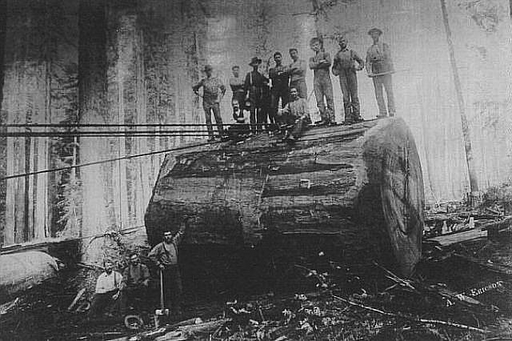
Just look at the length of the hand saw they needed
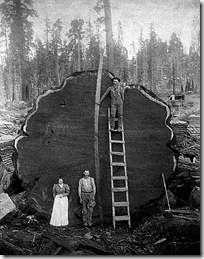
And look at the size of the heavy duty axes.

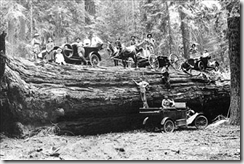
After a tree was felled the real work began – a week or more to cut it up.
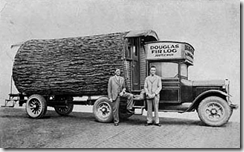
The work required very strong and courageous men.
Some of the logs were larger than the train engine.
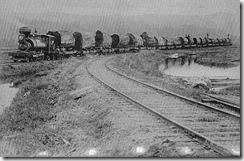
A hollowed out log became the company’s mobile office.
Hollowed out logs were also used to house and feed the crews.
 . .
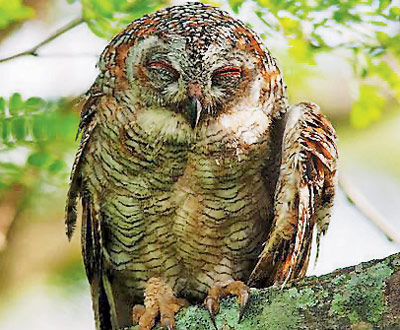 Staying alive: A mottled wood owl. The species can be found only in Staying alive: A mottled wood owl. The species can be found only in India, but it is fast losing its nesting sites because of tree-felling
.
Study: Owls play vital role in preserving environment
by Adnan Attarwala, 20120117, ^ Western Maharashtra, India, ^http://www.mid-day.com/news/2012/jan/170112-pune-Study-Owls-play-vital-role-in-preserving-environment.htm
.
‘A study conducted for the first time on five different species of owls inhabiting Western Maharashtra by city-based ornithologist Dr Satish Pandey, a fellow at the Maharashtra Academy of Science, has revealed how these nocturnal birds, who are losing their habitats because of environmental destruction and other superstitions, play a very important role in safeguarding the environment.
Five species of owls belonging to the Family Tytonidae (barn owl) and the Family Strigidae (Indian eagle owl, brown fish owl, mottled wood owl and spotted owlet) co-inhabiting the Deccan Plateau, the coastal region of Konkan and adjoining places were studied to understand preference habitat, reproductive behavior and food niche partitioning from 2005 till 2008.
The study was presented at the 7th Asian Raptor Research and Conservation Network (ARRCN) Symposium on Migratory Bird held in Korea last week on how the owl’s diet can be useful as a means of biological control of agriculture pests.
The studies revealed that spotted owlets and Indian eagle owls had the most compact habitat clusters, indicating a more specific habitat requirement, namely scrubs and grasslands. But since most of the lands are under development, the owls are fast disappearing. As the owls feed on rodents, birds, reptiles and insects and spend longer time in agricultural habitats, they are being subjected to anthropogenic activities and other interferences.
Mottled wood owls, which prefer deciduous forests are found only in India and inhabit mainly forested areas, where the use of pesticides is leading to problems as they eat rodents. Also, as they are tree-hollow nesting species, they are fast losing their nesting sites because of the felling of trees in their inhabited areas.
Barn owls and brown fish owls occupy more diverse habitats, with the latter preferring more water bodies and evergreen forests in their habitat. Due to the rampant destruction of rivers and lakes in Deccan Plateau, the birds have almost disappeared and have gone to upper streams as they require greener patches.
“We selected an area of 1,000 m radius around the nest in order to analyse the landscape features in all of the nest territories and visited each nest at least five times. We collected pellets of digestive foods, which were scrutinised by experts from Zoological Survey of India (ZSI),” said Dr Pande.
The study, besides understanding owl habitats, also included data based on Pianka Niche Overlap Index (PNOI) which suggested that spotted owlets and Indian eagle owls had maximum food overlap in terms of mammalian, avian, reptilian and insect prey, followed by barn owls and mottled wood owls, which are generalist feeders without specific food preference, while brown fish owls had the less overlap as they ate fish.’
.
About Dr Satish Pandey:
‘Dr Satish Pandey is an Interventional Vascular Radiologist and Assoc. Professor of Radiology at BJ Medical College. He works in ecology and field ornithology and has made several video films on raptor ecology, marine ecosystem and conservation, has published more than 40 papers and has authored several field guides and popular books on ornithology, nature education, orchids and other subjects to promote conservation.’
.
 . .
Friday, May 18th, 2012
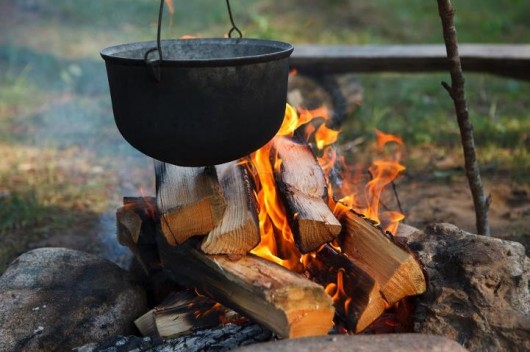 The classic image of the ‘Camp Fire’
The classic image of the ‘Camp Fire’
.
Australia’s tradition of the ‘Wood Fire’ is ecologically destructive
.
During Australia’s winter months, many in older homes habitually yearn for the warmth and glow of a traditional Wood Fire, and so utilise their open fire places and wood heaters. So habitually, upon the onset of winter people stock up on Firewood. It is a cultural yearning for the nostalgia of the Wood Fire – warm, earthy, dancing flames, flickering, spark spitting, the woodsmoke – we’ve all been there, it is tantalising and it feels right because it is natural – the ancient campfire tradition across humanity. In doing the Wood Fire ritual, we seek to rekindle our connection to Nature.
 The warmth and glow of a traditional Open Fire
…but the demand is driving deforestation of Ironbark Forests The warmth and glow of a traditional Open Fire
…but the demand is driving deforestation of Ironbark Forests
.
In earlier times when a few hundred of us settled in a given forest region, few forest resources were taken and so the forests replenished and seemed to cope. The forests were naturally resilient.
But as subsequent human hoards have invaded the land, and have bred and sprawled across the countryside in the hundreds of thousands, we have deforested entire forests in the process. These forests haven’t coped with the devastation. No forest could cope.
Australia’s native forests have been hacked, logged, burned and bulldozed into agrarian pasture to the horizon. Australia’s original blanket vegetation cover has been reduced to sad islands barely able to support wildlife habitat and in many cases causing extinctions – locally, regionally and nationally. All one needs do is a Google Earth search to appreciate the devastation on the natural landscape.
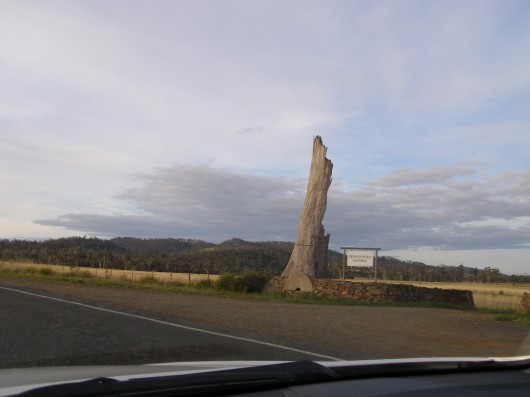 A legacy of forestry A legacy of forestry
.
Humanity’s sheer numbers and the encouraged consumption rate of Australians risk exacerbating the deforestation. Contemporary Australia is simply extending and perpetuating the old colonial exploitive mindset and a lifestyle reminiscent of 19th Century invading colonists.
The cultural heritage of the Wood Fire is necessarily contributing to this deforestation, particularly to Australia’s native Box-Ironbark Forests.
For Australians to continue to yearn for the glow, warmth and woodsmoke of the traditional Wood Fire now that we number in the hundreds of thousands, if not millions, and so the aggregate consumption of timber for firewood has simply become unsustainable. Our native forests have become too small and disparate to sustain wildlife breeding.
The few shrinking native forests that our forebears and their frenzied clearing have left us, simply are disappearing. Australia’s remnant native forests continue to be destroyed by us just to serve this selfish cultural yearning for earthy nostalgia of the Wood Fire. The same applies to all woodheaters.
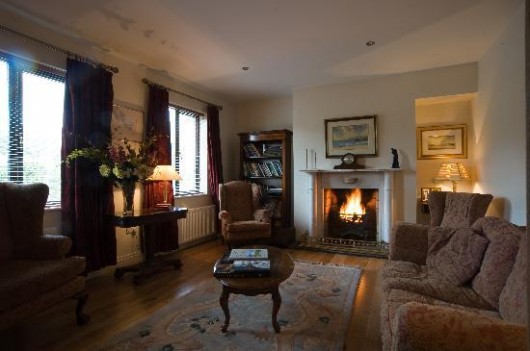 A classic wood fire in an old style open fireplace A classic wood fire in an old style open fireplace
.
The Australian Wood Fire cultural imperative through winter has become a driver of forest extinctions. There have become too many of us wanting tonnes of the forest to burn in our open fires and wood heaters, and too few forests left.
Australia’s firewood demand is driving deforestation. There is estimated to be around 800,000 wood heaters and 700,000 open fire places in Australia (ANZECC, 2001). There combined use is unsustainable and has got to stop! We need to question this inherited and habitual Open Fire/Woodheater culture and the devastating impact it is causing to our native forests.
.
“One of the hidden environmental issues affecting Australia’s woodlands, the collection of firewood, is starting to be revealed. CSIRO has prepared a report, Impact and Use of Firewood in Australia, pointing out alarming environmental problems.
For example, up to 6 million tonnes of fuelwood is consumed in Australia each year – double the amount of annual exports of eucalypt woodchips!”
[Source: ‘Firewood Conference’ in Armidale, NSW, May 2001, ^http://dazed.org/npa/npj/200102/FebYourNPA.htm]
.
Commercial Firewood is Forest ‘Eco-theft‘
.
Firewood taken from a native forest for personal use is one thing. The scale and severity of adverse impact upon forest ecology will vary according to the amount taken and the ecological sensitivity of the place it is taken from. Few domestic takers of firewood will be qualified ecologists and so will have no or little comprehension or respect for such impacts.
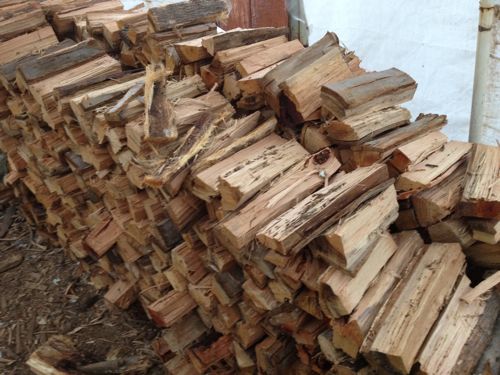 A private firewood stack A private firewood stack
.
According to the CSIRO, up to 5.5 million tonnes of timber is harvested annually for Australian domestic firewood use. When industrial firewood use is included, the total amount rises 20% to between 6-7 million tonnes. This weight is roughly double the amount of eucalypt currently exported annually from Australia as woodchips. About half of all domestic firewood is collected by the consumer and 84% of domestic firewood is collected on private property. [CSIRO, 2000]
Across Australia, access to State Forests is unfettered and the collecting of firewood for personal (domestic) consumption is an uncontrolled free-for-all, little improved from the exploitative mindset of Australia’s early and more ignorant colonists.
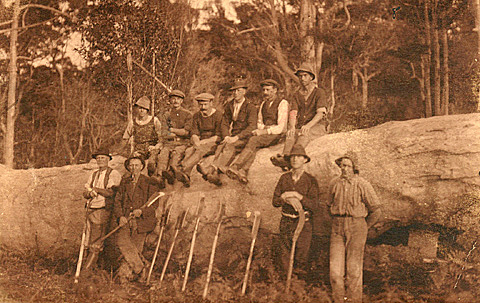 Australian colonial ‘progress’ Australian colonial ‘progress’
.
Deforestation by firewood taking is perhaps not as broadscale and well known as the Conservation Movement’s exposure of state-sanctioned Industrial Logging by the likes of Australian state government departments:
- ‘VicForests‘ (Victoria)
- ‘Forests NSW‘ (New South Wales)
- ‘Forestry SA‘ (South Australia)
- ‘Forestry Tasmania‘ (Tasmania)
- ‘Forests and Wood‘ (Queensland)
- ‘Forests Products Commission‘ (West Australia)
.
Or is it?
It is Australia’s Commercial Firewood Industry that contributes to the demise of Australia’s remnant native forests by its ‘death by a thousand cuts‘. Commercial Firewood entails the direct taking of wood from Australia’s native forests for commercial sale and profit. It is of a scale far greater than domestic forewood collecting, but where are the statistics kept and publicised by the Australian Government?
Just as demand for firewood drive supply, the artificial low economic cost of firewood encourages demand volume. Since firewood is sold a low cost, it competes favourably with jalternatiuve sources of fuel, such as gas and electricity, for domestic heating. Commercial firewood suppliers also deliberately appeal to the Wood Fire cultural image to encourage their firewood sales. Suppliers and consusmers thus feed off each other at low cost and high volumes, and so more native forests lose out.
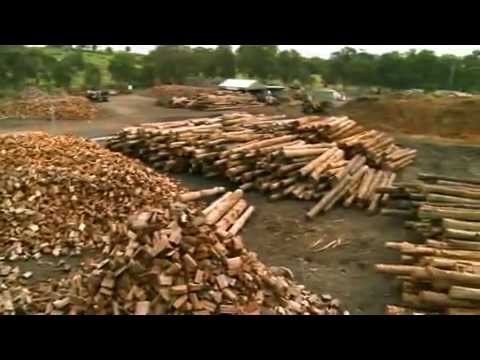 A commercial firewood stack A commercial firewood stack
.
The low or no cost availability of timber from State Forests Native timber means that the industry operates on an industrial scale taking vast quantities of timber, particularly from the preferred hardwood Box-Ironbark Forests and the like. The Commerical Firewood Industry is encouraged by the Australian Government and by all state governments, which ignore the practice as if Australia’s natuve forests are unlimited, as if it had no adverse ecological impact upon the forest ecologies, as if it didn’t matter, as if there were no tomorrow.
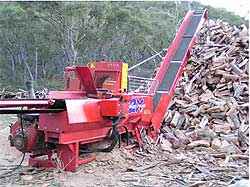 Commercial Firewood Production
Norwegian Hakki-Pilke industrial machinery enables an industrial scale operation
[Source: Mascus Australia, ^http://www.mascus.com.au/] Commercial Firewood Production
Norwegian Hakki-Pilke industrial machinery enables an industrial scale operation
[Source: Mascus Australia, ^http://www.mascus.com.au/]
.
Across Australia, each state government issues cheap permits for collecting firewood from State Forests.
This reflects:
- A cultural disregard for the values of Australia’s disappearing forest ecologies up to Prime Ministerial and Cabinet level
- The inadequacies of State laws to protect forest ecology
- An antiquainted colonist mindset persisting throughout the dominating Liberal and Labor parties.
.
The ecological impacts and the plethora of ecological advice and warnings about the destructive impacts of logging on forest ecology are being ignored. Australia’s Commercial Firewood Industry fuels demand for cheap firewood and in the process exacerbates Australia’s deforestation.
Australia’s Firewood Industry is unsustainable and has got to be nationally controlled. We need to challenge this exploitative industry and correct ignorant government policies. We need to find alternatives to the Wood Fire to stem the devastation of Australia’s remaining native forests and to help prevent more wildlife extinctions.
.
‘Forest Eco-theft’ involves the immoral taking of timber from a native forest, especially in large industrial quantities, for commercial gain and incurring no or little economic cost to the taker. The intended or actual use of the timber is irrelevent, but may include logs, firewood, craft timber, or woodchips. The greater the timber volume taken, the greater impact upon a forest and so the more serious the Eco-theft.
.
‘Eco-theft’ is only different to criminal theft because of the colonist exploitative mindset of current governments rejecting native forest having ecological value worthy of protection under the Crimes Act.
.
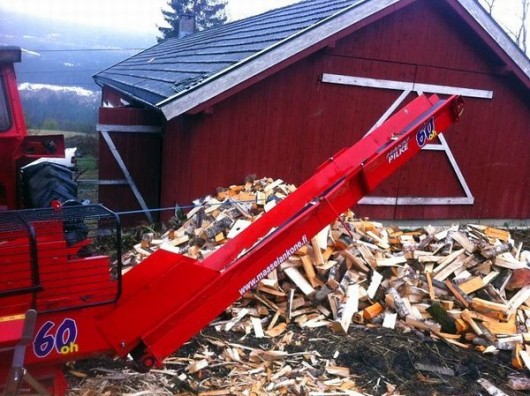 An industrial scale Hakki-Pilke firewood processor from Norway An industrial scale Hakki-Pilke firewood processor from Norway
.
Forest Eco-theft in an environment of dwindling forest habitat has become a key threatening process. At the current rate of Forest Eco-theft, Australia’s native forests fueling our pleasure for earthy glows and hearth warmth, will be gone.
Firewood Logging simply destroys forest habitat and contributes to the demise and local extinctions of threatened and endangered wildlife. Australia’s flora and fauna deaths and ultimate extinctions has become infamy – Australia currently has the worst record of mammalian extinctions on the planet, and the Firewood culture is contributing to it.
Many consumers of firewood either actively couldn’t care, or else passively turn an insular blind eye to the adverse ecological impacts of firewood harvesting. Our Australian Government ignores the firewood deforestation problem, avoiding it for party political convenience – immorally, irresponsibly and unrepresentingly.
Just as Poaching Wildlife is immoral, so too is Forest Eco-theft. Both these exploitative practices hark to colonial times and need to be banned.
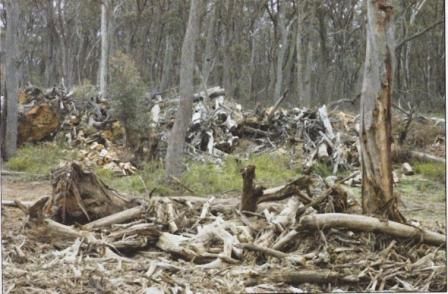 Firewood Logging of State Forest near Taralga NSW in 2006.
(along the Goulbourn-Oberon Road, just west of the Blue Mountains)
“This is in the habitat of Diuris aequalis. Had a fair result after two visits to this site and three submissions to local Council. Department of Environment and Conservation have imposed rigid conditions on this business.” Firewood Logging of State Forest near Taralga NSW in 2006.
(along the Goulbourn-Oberon Road, just west of the Blue Mountains)
“This is in the habitat of Diuris aequalis. Had a fair result after two visits to this site and three submissions to local Council. Department of Environment and Conservation have imposed rigid conditions on this business.”
[Source: ‘Habitat – Protection or Destruction‘, 2006, by Alan W Stephenson, Conservation Director, Australian Orchid Council Inc.
^http://www.orchidsaustralia.com/article_%20conservation_no3.htm]
.
.
Why choose ‘Ironbark Firewood’ ?
.
Why choose Ironbark Firewood ? Why not choose an alternative sources of fuel for home heating? Never thought to question the legitimacy of your fuel?
Here’s the justification by one firewood supplier as to why one should choose Ironbark Firewood:
- ‘Long Burning. Harder to start but will burn 6 – 8 hours. These timbers are the slowest growing and the hardest of all hardwoods.’
- ‘Very little ash. Clean out fire only once per season approximately.’
- ‘Strong Burning. Cannot be put out even if the vent closed, unless water is used.’
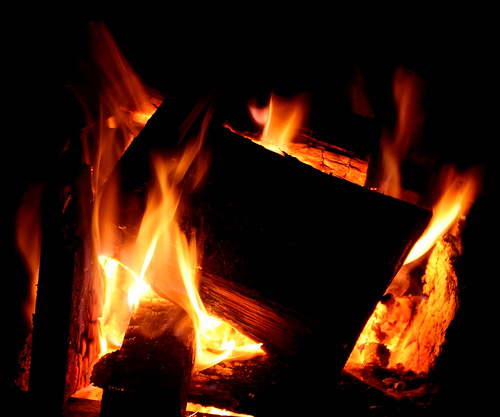 A classic Ironbark ‘Open Fire’ A classic Ironbark ‘Open Fire’
.
The most common type of firewood commerically sold and promoted in the eastern Australian states is Ironbark Firewood. This is typically sourced from Box-Ironbark Forests (native grassy woodlands).
According to the Firewood Association of Australia (FAA), Ironbark and Box are the preferred firewood in Queensland, while in Victoria, southern NSW and South Australia, River Red Gum is preferred. Jarrah and Wandoo hardwood timbers are preferred in Western Australia, while in Tasmania, Brown Peppermint is considered the best firewood.
[Source: ^http://www.firewood.asn.au/faq.html]
.
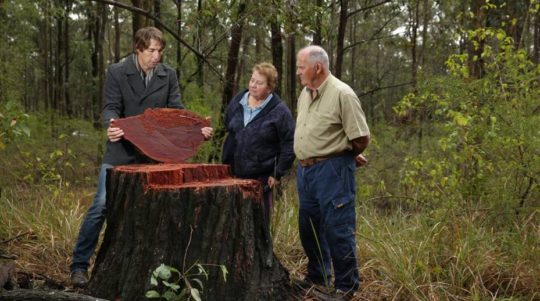 What the hell?
Old Growth cut up for cheap firewood? What the hell?
Old Growth cut up for cheap firewood?
[Source: “Environmental vandals” cut down 100-year-old trees on land at East Maitland, 20180905, by Donna Sharpe, ^https://www.beaudeserttimes.com.au/story/5629093/chainsaw-massacre-environmental-vandals-cut-down-100-year-old-trees/]
.
Sydney’s Firewood has been linked to ongoing Queensland land clearing, and in Queensland successive backward state governments have an ignoble reputation for land clearing like there’s no tomorrow.
Landclearing in Queensland has become the major supplier of Sydney’s quality firewood. Most of Sydney’s big firewood companies now rely on the Sunshine State for a significant proportion of ironbark and box logs – highly sought-after timbers because of their density. The National Parks Association says firewood from endangered Queensland woodlands is being used in homes across New South Wales.
Back in 2001, the National Parks Association of NSW called on the NSW Government to limit the State’s use of firewood following revelations that most of the wood sold by Sydney’s big firewood companies comes from clearing of Queenslands threatened Ironbark and Box woodlands.
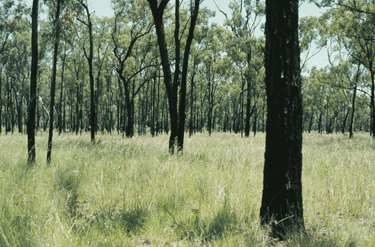 Ironbark Woodland of Central Queensland
[Australia Natural Resource Atlas] Ironbark Woodland of Central Queensland
[Australia Natural Resource Atlas]
.
At the time, Mr Charlie Spiteri, the owner of Betta Burn Firewood, one of the biggest suppliers in Sydney, refused to reveal how much firewood he supplies each year but estimates that the Sydney region, including Katoomba, consumes about 100,000 tonnes.
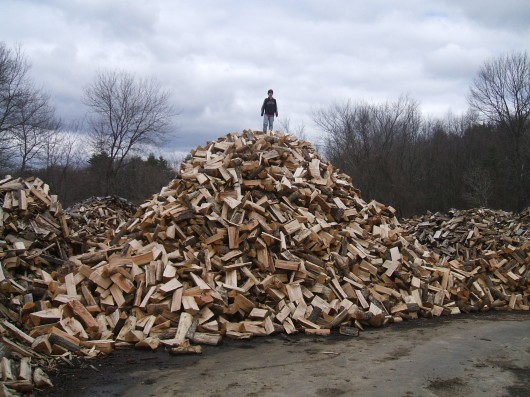 Commercial Firewood stockpile
(click photo to enlarge) Commercial Firewood stockpile
(click photo to enlarge)
.
Spiteri said about a third of his supply was sourced from Queensland, where the wood is worth between $40 and $50 a cubic metre. By the time the freight reaches Sydney, it is worth up to $125 and is being snapped up. “People are choosing ironbark and box and we have to go where the timber is,” Mr Spiteri said.
Other major sources of hardwoods for Betta Burn include the Pilliga State Forest in north-west NSW and private properties in the Nyngan area.
Executive officer at the National Parks Association (NSW), Mr Andrew Cox, said:
“Firewood collecting is the second largest threat to Australia’s temperate woodlands after land clearing. Now its being linked to landclearing!” “We know little about the impacts of firewood collecting and governments have been slow to take an interest. Most firewood consumers are unaware of where their wood comes from or the huge impact it has on threatened animals, birds and reptiles.”
“The firewood industry is large, but mostly unknown”, said Andrew Cox, NPA Executive Officer. “About 1,500,000 tonnes of firewood are used by New South Wales each year, exceeding the State’s yearly combined production of sawlogs and woodchips.”
“Firewood collecting targets slow-growing ecosystems and some of their most important components. Eucalypt species such as ironbark, box and red gum are the most favoured firewood sources.”
“We need to move away from the need to ‘clean-up’ a forest or woodland and instead look at dead wood as an important ecological component – just as important as the living trees.”
“Its because we’re not properly managing the woodlands that a wave of bird extinctions is underway in central NSW. More than 20 woodland dependent birds are declining from their former range and may become extinct in NSW. “It’s not ecologically sound, it’s not sustainable and there are serious impacts on birds, on animals that depend on the hollows.”
But no-one knows for sure how much timber salvaged from the bulldozed woodlands of Queensland is making its way south of the border in convoys of semi-trailers. Firewood collection operates in a legal vacuum – especially on private land – and virtually no figures are kept for where wood is sourced or how it is collected.
[Source: ‘Sydney’s Firewood Linked to Queensland Land Clearing‘, by Andrew Cox, Executive Officer, National Parks Association of NSW, 20010428, ^http://dazed.org/npa/press/20010428firewood.htm]
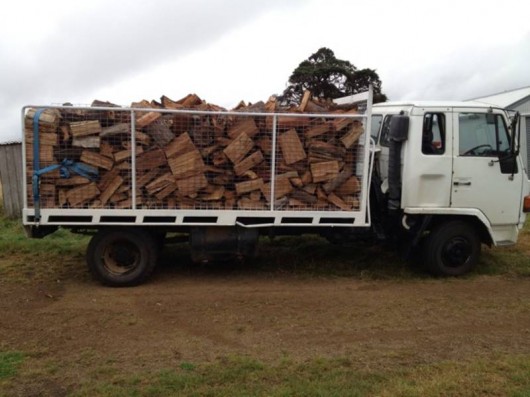 A typical commercial firewood truck – 2 tonne?
A typical commercial firewood truck – 2 tonne?
.
Since then, over a decade ago, what has changed? Anything? Nothing? Has the problem gotten worse?
.
83% of the original Box-Ironbark Forests have gone
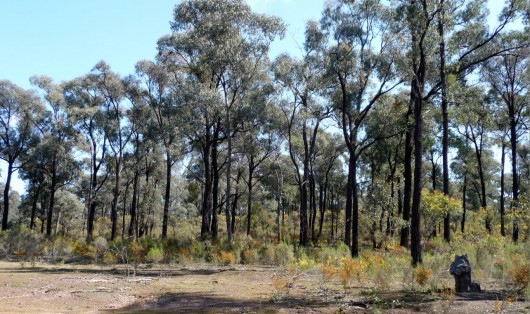 Box Ironbark forest in central Victoria dominated by Red Ironbark (Eucalyptus tricarpa)
Box Ironbark forest in central Victoria dominated by Red Ironbark (Eucalyptus tricarpa)
[Source: Ian Lunt’s Ecological Research Site, ^http://ianluntresearch.wordpress.com/2012/01/20/fire-and-rain-2-water-for-ironbarks/]
In Victoria, few forest and woodland ecosystems are as poorly represented in parks and reserves as the distinctive Box-Ironbark ecosystems of northern Victoria.
Since European settlement these forests and woodlands have been extensively cleared and fragmented for agriculture, urban development and gold mining, and cut for a variety of wood products. They once covered three million hectares of northern Victoria, but 83% of the original Box-Ironbark vegetation has now been cleared.
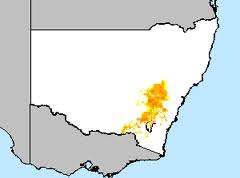 Original distribution of grassy woodlands across New South Wales
Original distribution of grassy woodlands across New South Wales
(Dominated by Box-Ironbark Forests)
.
Not only have the forests and woodlands been mostly cleared, but what is left is highly modified from its original structure and is also very fragmented. These remaining forests and woodlands are mostly on public land and these areas are ecologically important for a rich diversity of flora and fauna, many of which are rare or threatened.
Box-Ironbark forests and woodlands are highly accessible and the visitor is rewarded by a vibrant array of bird species, carpets of wildflowers in Spring, the rich aroma of eucalypt nectar, and many sites of historical and cultural interest. Despite their apparent uniformity, these forests actually have great diversity with around 1 500 species of higher plants and over 250 vertebrate species recorded in the region; many are largely restricted to Box-Ironbark forests and woodlands.
Some 297 Box-Ironbark plant species and 53 animal species are now classified as extinct, threatened or near-threatened. In addition, at least ten plant and animal species are known to have disappeared from the study area since the 1840s, and numerous others have become locally extinct. It is also clear and of great concern that many species, particularly birds, are known to be still declining.
Accordingly, a key feature of Box-Ironbark nature conservation is the promotion of ‘recovery’ for many species, rather than simply maintaining the status quo. Many Australian animals are dependent upon large, old eucalypt trees which contain the hollows required for shelter and breeding. At least six of the threatened Box-Ironbark fauna species are strongly dependent upon these trees. The massive loss of large old trees over the last 150 years is strongly implicated in the decline of these species and perhaps many others. It is therefore recommended that as well as protecting existing large old trees, additional measures be taken to ensure that there will, over time, be more large old trees in the forests.
[Source: ‘Box-Ironbark Forests & Woodlands Investigation‘, (Environment Conservation Council, 2001), Executive Summary, by The Victorian Environmental Assessment Council, 2001, ^http://www.veac.vic.gov.au/documents/385-Executive-Summary.pdf]
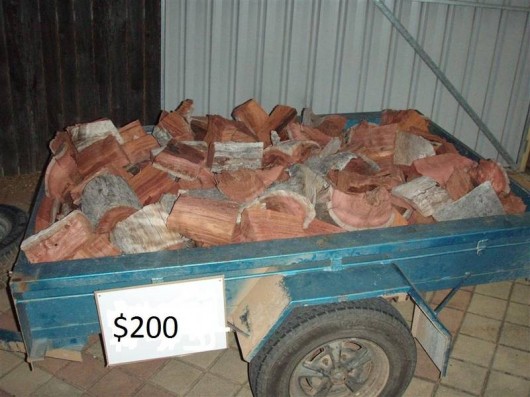 . .
‘Why is Firewood so cheap?
.
Ironbark is a preferred firewood in eastern Australia because it burns longer and hotter, so Australia’s native Ironbark forests continue to be logged for firewood.
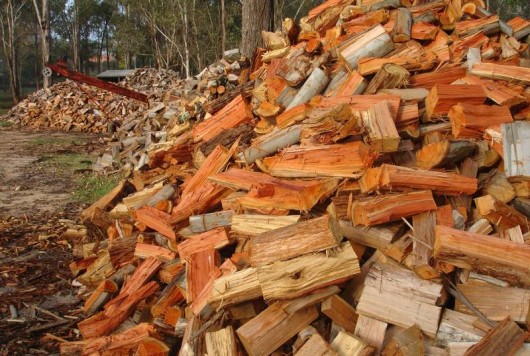 Ironbark firewood stack, commercially cut and split ready for domestic delivery Ironbark firewood stack, commercially cut and split ready for domestic delivery
.
The Australian hardwood timber industry now mainly relies upon plantation timbers and sustainable forestry management practices. Australian Ironbark Flooring retails at a premium price at typically over $80/m2 at 19mm thick. If that square meter of flooring was stacked one metre high to achieve a cubic metre, the calculated retail price for a cubic metre would be (1000m/19mm = 50 layers of flooring roughly, making the retail price for a cubic metre of Ironbark flooring around $80 x 50 = $5600/m3!
 Expensive Ironbark Flooring
Sourced from sustainable plantation timber, unaffordable to the Commercial Firewood Industry,
so firewood suppliers take the Ironbark out of State Forests instead.
[Source: Northern Rivers Timber, ^http://www.northernriverstimber.com.au/gallery.php] Expensive Ironbark Flooring
Sourced from sustainable plantation timber, unaffordable to the Commercial Firewood Industry,
so firewood suppliers take the Ironbark out of State Forests instead.
[Source: Northern Rivers Timber, ^http://www.northernriverstimber.com.au/gallery.php]
.
But commercial suppliers of firewood do not own plantation timber, nor do they buy their firewood from plantation timber growers. They certainly do not pay $5,600/m3 for firewood.
Commercial firewood is generally sold at considerable profit at under $160/m3, reducing in price according to volume purchased. Why would an commercial grower of plantation Ironbark hardwood sell the timber for firewood at $160/m3, when as flooring the typical market price is a factor of some 35 times greater at $5600/m3?
.
Commercial Firewood taken from native forests means that the $160 selling price is nearly all profit!
.
Australia’s commercial firewood instead is simply taken from Australia’s native hardwood forests. It is simply taken from State Forests at no cost to the commercial operator, except for a pultry token permit fee. That is why it is sold so cheaply.
This is why firewood remains a cheap affordable source for domestic household heating. But the cost is artifically economic and excludes the ecological cost.
How is this not Forest Eco-Theft? If the suppliers of Ironbark Firewood had to pay hardwood plantation owners a fair wholesale price for firewood, at such a high price their business model would be unviable. Firewood suppliers only exist because their business model relies upon firewood theft from dwindling State Forests, which continues to go unpoliced and ignored by the Australian Government.
 Industrial Firewood Industry Industrial Firewood Industry
.
Where do YOU get your FIREWOOD from?
.

- Where do you get your firewood from?
- Is it legal or eco-stolen?
- Is it accredited?
- What is Australia’s Firewood Industry doing to protect Australia’s long exploited and dwindling Ironbark Forests from firewood theft by firewood suppliers?
- What is the Australian Government doing to prevent firewood theft from State Forests?
- What is the Australian Government doing to monitor and control Australia’s firewood industry?
- Who in the Australian Government monitors the integrity and ecological protection of State Forests across New South Wales and indeed across Australia?
- Where is the ongoing review and analysis into the ecological health of Box-Ironbark Forests (Grassy Woodlands) across New South Wales and Victoria?
- Why are the statistics on firewood theft from State Forests not collected and publicised?
- Who polices and penalises deforestation of State Forests?
- How many people are caught and fined/gaoled for deforestation of State Forests
- Isn’t it illegal to steal firewood from State Forests – living trees or deadwood?
.
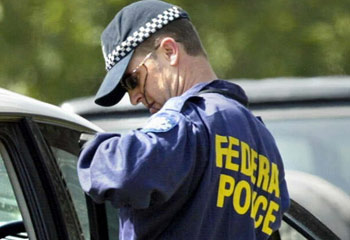
At the time of publication of this article, the New South Wales Government’s official website on Environment and specifically on Threatened Species reads:
“There has been a serious system failure on the threatened species website (www.threatenedspecies.nsw.gov.au) and it is no longer available”
[Source: ^http://www.environment.nsw.gov.au/threatenedspecies/]
.
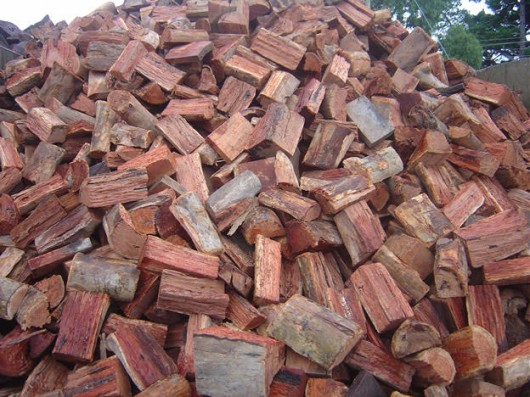 Pile of Ironbark Firewood cut and split ready for domestic delivery Pile of Ironbark Firewood cut and split ready for domestic delivery
.
In the Blue Mountains of New South Wales, the local newspaper advertises numerous suppliers of firewood, particularly at the onset of winter, and particularly promoting Ironbark Firewood as the premium product as follows:
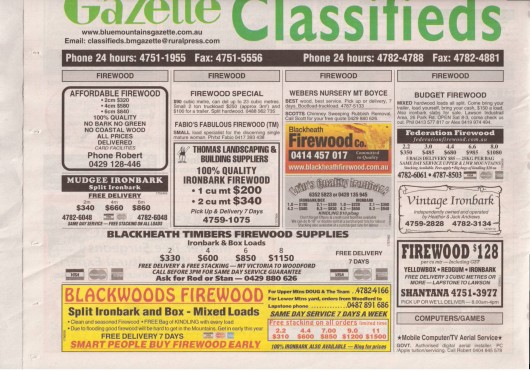
Firewood suppliers advertising in the Blue Mountains Gazette, 20120516
.
But from where do these firewood suppliers source their firewood?
Not one of the above advertisements provides any proud statement about sourcing their wood ecologically responsibly, nor about being ecologically accredited. The default presumption thus is that none of these suppliers is environmentally responsible, nor accredited. So don’t buy from any of them!
Is the advertised firewood sourced illegally from Australia’s disappearing Box-Ironbark Forests, and so exacerbating the deforestation problem? How do we know it isn’t?
How simple is it for any common thief to buy a chainsaw, drive out to a patch of State Forest in a ute or in a truck or with a trailer in tow, then chainsaw several trees in a Box-Ironbark Forest, paying nothing for them, then flog the wood for personal profit? Too easy! Anyone can buy a chainsaw from a local garden tool supplier, even a kid. There are no chainsaw laws in Australia. It is treated like buying secateurs. Bunnings sells cheap chainsaws brand-new for just $200!
So armed with a trailer and chainsaw, a common thief has a lucrative business, one ignored by the Australian Government. With firewood retailing from $160/cubic metre, it is a nice little earner. This exploitative immoral trade in Ironbark Forest ecology is negligently condoned by the Australian Government and state governments.
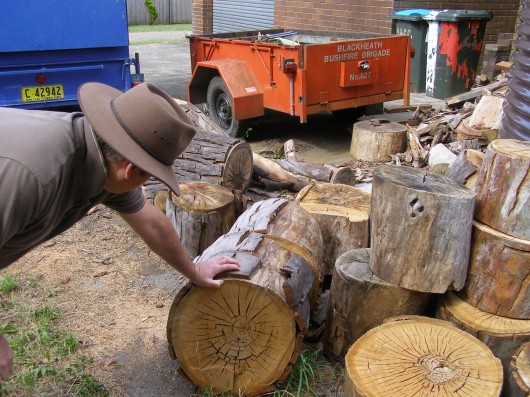 A native tree cut for firewood
A native tree cut for firewood
(Blackheath Fire Brigade, Rural Fire Service, Blue Mountains, November 2011)
.
‘Forest Eco-theft’ wiping out Ironbark Habitat
.
Logs have life inside
.
‘Collecting firewood is one of humankind’s oldest activities. Australians enjoy the beauty and warmth of a wood fire, and in many regional areas wood fires are the only practical source of heating.
Dead trees, often with hollows, make popular firewood as they are seasoned and burn well. But firewood collection comes at a cost to the environment, the consequences of which may not be entirely understood for years. Many firewood users are unaware of the ecological price of collecting dead trees and fallen logs. Often they mistakenly think they are just keeping the forest or farm tidy.
Firewood harvesting has an effect on our native woodlands, and a variety of threatened species. Dead standing and fallen timber provides crucial habitat for numerous species of animals and birds. It is now recognised that the removal of this wood for firewood is contributing to a significant loss of wildlife, particularly in the woodlands of south-eastern Australia. It is not just native animals that benefit from old wood left lying on the ground. This debris is valuable shelter for stock too. How many times have you found a newborn calf or lamb against an old log safe from the weather?
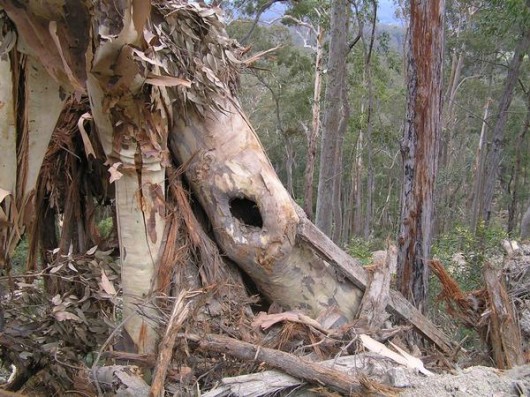 Habitat Tree of critical value to wildlife
…destroyed by Forestry NSW Habitat Tree of critical value to wildlife
…destroyed by Forestry NSW
.
Not only does standing and fallen dead wood provide important habitat for animals and birds, it also plays an essential role in maintaining forest and woodland nutrient cycles. Scientists from the CSIRO believe that dead wood is at least as important as living trees, fallen leaves and soil for the maintenance oif ecological processes sustaining biodiversity.’
[Source: ‘Are you burning their homes to warm yours?‘, a brochure questioning the dependency on firewood), by The National Heritage Trust. The Natural Heritage Trust (the Trust) was set up by the Australian Government under the Natural Heritage Trust Act 1997 to help restore and conserve Australia’s environment and natural resources. The Trust had three overarching objectives: (1) Biodiversity Conservation, (2) Sustainable Use of Natural Resources, and (3) Community Capacity Building and Institutional Change. The Natural Heritage Trust ceased on 30 June 2008. It has been replaced by Caring for our Country, but taking supplanting a natural heritage conservation philosophy with a more anthropocentric utilitarian ‘resource management’ philosopy, ^http://www.nrm.gov.au/]
.
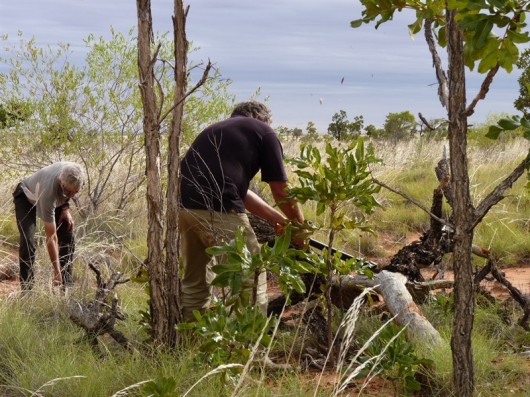 Cleaning up some messy dead timber – through whose eyes?
Nature is naturally ‘messy’
Cleaning up some messy dead timber – through whose eyes?
Nature is naturally ‘messy’
.
The Regent Honeyeater has become a ‘flagship species’ for conservation issues in the box-ironbark forest region of Victoria and New South Wales.
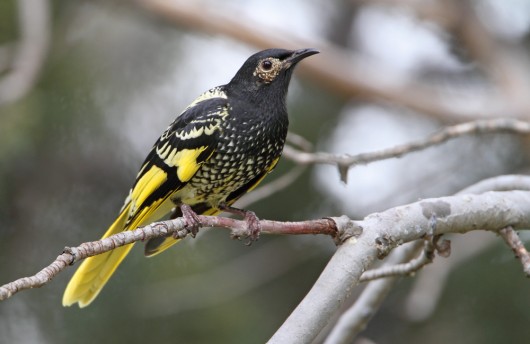 Regent Honeyeater (Anthochaera-phrygia)
Nationally listed as ‘Endangered‘.
Listed as endangered in Queensland and New South Wales, while in Victoria it is listed as threatened.
[Source: ^http://www.birdsinbackyards.net/species/Anthochaera-phrygia] Regent Honeyeater (Anthochaera-phrygia)
Nationally listed as ‘Endangered‘.
Listed as endangered in Queensland and New South Wales, while in Victoria it is listed as threatened.
[Source: ^http://www.birdsinbackyards.net/species/Anthochaera-phrygia]
.
Australia’s native Regent Honeyeater, was formerly more widely distributed in south-eastern mainland Australia from Rockhampton, Queensland to Adelaide, South Australia, but is now confined to Victoria and New South Wales, and is strongly associated with the western slopes of the Great Dividing Range. Its natural habitat is eucalypt forests and woodlands, including Box-Ironbark Forests.
The Regent Honeyeater has been badly affected by land-clearing, with the clearance of the most fertile stands of nectar-producing trees and the poor health of many remnants, as well as competition for nectar from other honeyeaters, being the major problems. Birds Australia is helping to conserve Regent Honeyeaters as part of its Woodland Birds for Biodiversity project.
[Source: Birds Australia, ^http://www.birdsinbackyards.net/species/Anthochaera-phrygia, and further references: ‘Field guide to the birds of Australia, 6th Edition’, ‘The Honeyeaters and their Allies of Australia’]
.
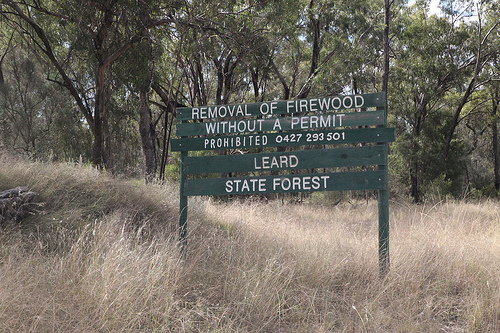 Leard State Forest Leadership
(New South Wales)
[Source: ^http://www.kateausburn.com/2012/04/10/leard-state-forest-next-frontier-of-the-coal-industry/] Leard State Forest Leadership
(New South Wales)
[Source: ^http://www.kateausburn.com/2012/04/10/leard-state-forest-next-frontier-of-the-coal-industry/]
.
Further Reading:
.
[1] ‘Box-Ironbark Forests & Woodlands Investigation‘, by The Environment Conservation Council, 2001) by The Victorian Environmental Assessment Council, Australia,^http://www.veac.vic.gov.au/investigation/box-ironbark-forests-woodlands-investigation-ecc-
‘This report contains the ECC’s recommendations for public land use in the Box-Ironbark area of northern Victoria, extending from Stawell to Wodonga. The recommendations incorporate those for parts of the LCC’s North Central, Murray Valley and adjoining areas.’ (>Read Report, PDF 6.6MB – large file may be slow to load)
.
[2] ‘ National Approach to Firewood Collection and Use in Australia‘ , June 2001, Australian and New Zealand Environment Conservation Council (ANZECC), Australia,^ http://www.environment.gov.au/land/publications/pubs/firewood-approach.pdf (> Read Report , PDF 990kb)
.
[3] ‘ Impact and Use of Firewood in Australia‘, by Don Driscoll, George Milkovits, David Freudenberger, CSIRO Sustainable Ecosystems, Australia,^ http://www.environment.gov.au/land/publications/pubs/firewood-impacts.pdf, (> Read Report, PDF 400kb)
.
Tags: Box Firewood, Box-Ironbark Forests, Brown Peppermint, classic camp fire, Commercial Firewood Industry, domestic firewood, Eco-theft, firewood, firewood collecting, Firewood Logging, Forest Eco-theft, forest ecology, grassy woodlands, industrial logging, Ironbark Firewood, ironbark forest, Ironbark Woodland, Jarrah Firewood, land clearing, native forests, open fire, Pilliga State Forest, Red Ironbark, Regent Honeyeater, River Red Gum Firewood, State Forest, Wandoo Firewood, wildlife extinctions, wood fire
Posted in Birds (Australian), Threats from Deforestation | 5 Comments »
Add this post to Del.icio.us - Digg
Monday, May 14th, 2012
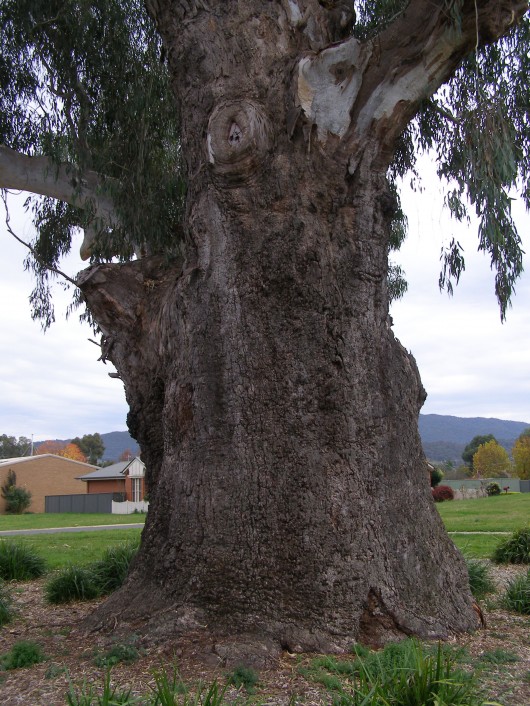 River Red Gum
(click image to enlarge) River Red Gum
(click image to enlarge)
.
Play music by Australia’s David Hyams: 
[Music source: ^http://www.milestogo.com.au/]
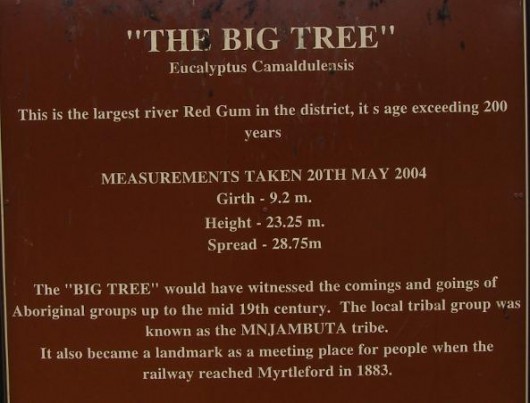
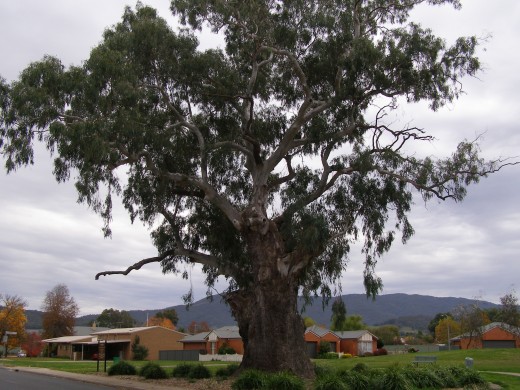 Myrtleford’s 200+ year old River Red Gum
(Eucalyptus camaldulensis) Myrtleford’s 200+ year old River Red Gum
(Eucalyptus camaldulensis)
.
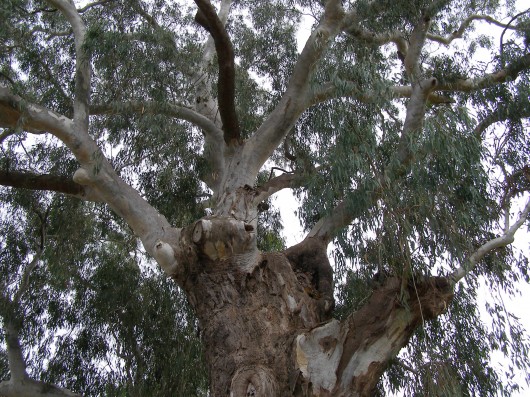 Native to riverine valleys particularly of heavy clay soils along river banks and on floodplains subject to frequent or periodic flooding across riverine northern Victorian and southern New South Wales.
Native to riverine valleys particularly of heavy clay soils along river banks and on floodplains subject to frequent or periodic flooding across riverine northern Victorian and southern New South Wales.
.
Most Australian trees, like native Australians, have otherwise been despised and slaughtered by Colonists…
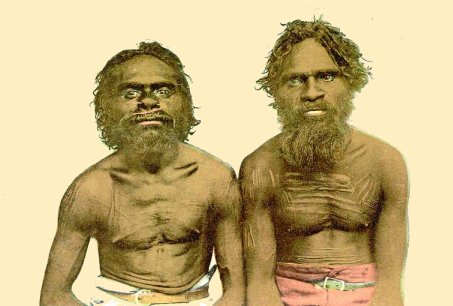 Indigenous Australians Indigenous Australians
.
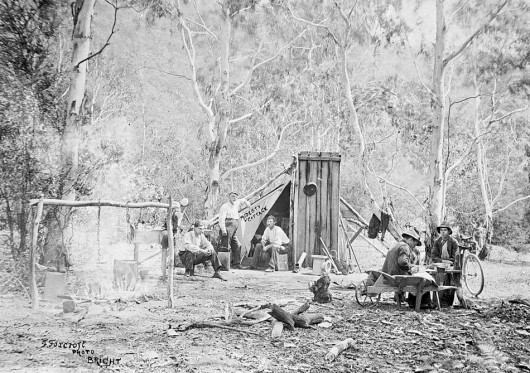 The township of Bright before the exotic trees.
In the 1890s when colonial miners exploited North East Victoria..
the Red Gum would have been just 80 years old.
. The township of Bright before the exotic trees.
In the 1890s when colonial miners exploited North East Victoria..
the Red Gum would have been just 80 years old.
.
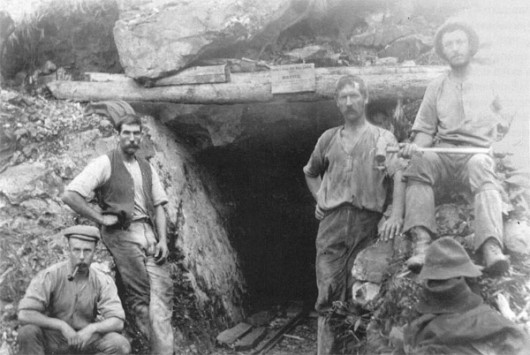 . .
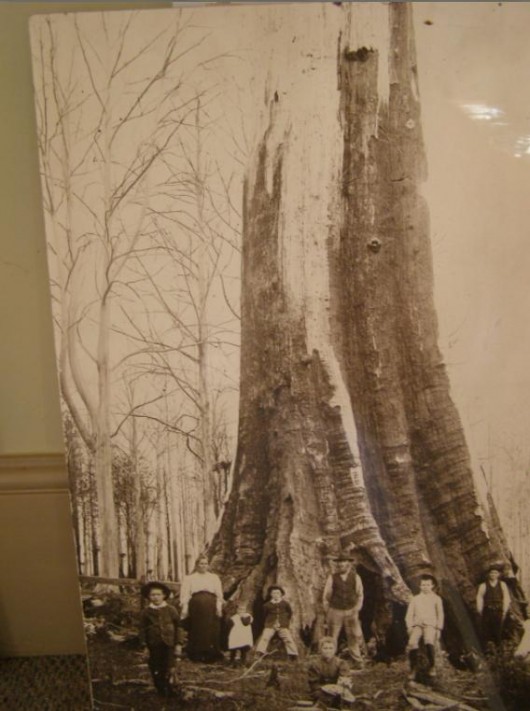 The ‘Penny Tree’
[Fumina, East Gippsland, Victoria, 1908] The ‘Penny Tree’
[Fumina, East Gippsland, Victoria, 1908]
.
..”As a result of the devastating bush fires which raged through Gippsland some 18 months ago, this Settler in the Fumina district was unfortunate enough to lose his home, and afterwards took shelter in this big hollow tree.
The space available was enough for 2 large beds, tables, chairs and sundry other furniture. Under the deft fingers of “The Lady of the Tree” it soon transofrmed into a comfortable home for the Family, until eventually replaced by a 6 roomed home some time later.”
[Source: The Weekly Times, 1908]
.
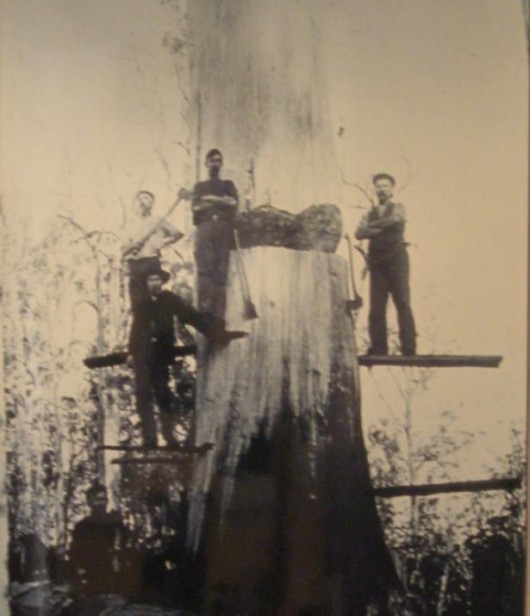 . .
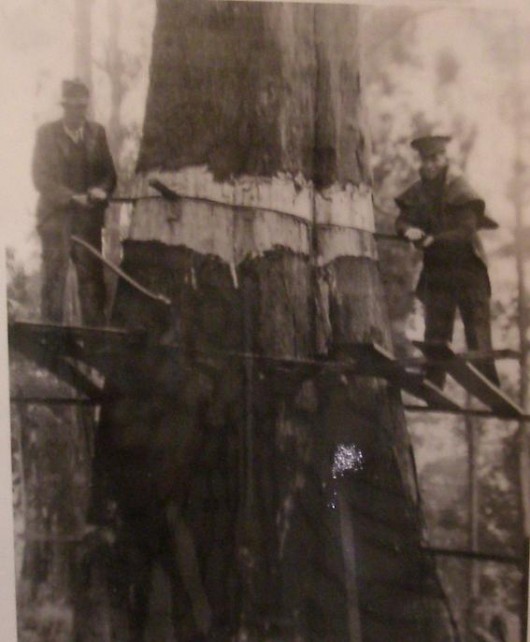
[Source: Forestry Museum, Beechworth, Victoria, Australia]
.
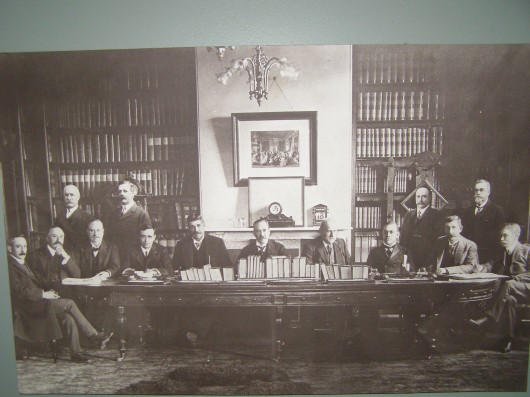 Victorian colonists driving ‘COLONIAL PROGRESS‘
(click image to enlarge) Victorian colonists driving ‘COLONIAL PROGRESS‘
(click image to enlarge)
.
Tags: Australia's old growth, Bright, colonial progress, East Gippsland, Eucalyptus camaldulensis, Fumina District, Logging, Mnjambuta, Myrtleford, North East Victoria, Penny Tree, River Red Gums, The Big Tree
Posted in Threats from Deforestation | 2 Comments »
Add this post to Del.icio.us - Digg
Sunday, March 4th, 2012
Some wee satire….
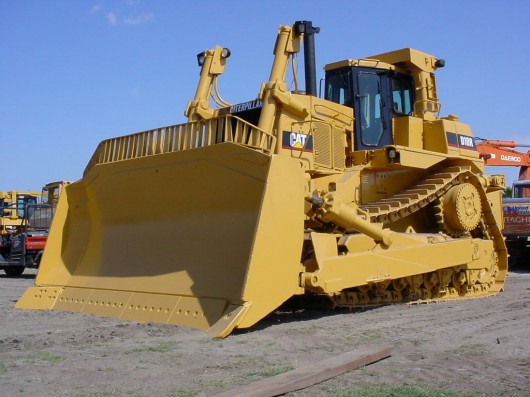
Dozer Rights
.
We are built to do a job
We do that job well
We clear unwanted rubbish,
debris, obstacles, clear roads, bushes, pesky trees,
in some god forsaken places – people and their homes
.
It’s not our fault we’re gaudy yellow
Can’t miss us that way!
We often work solo
in the middle of nowhere
And we go all day
We work hard! ..努力加油 “loh lik gah yau!“
.
But we’re persecuted
Many hate us
They don’t understand
It’s not our fault
We’re just following orders
It’s a dozers lot
We have rights too.
.
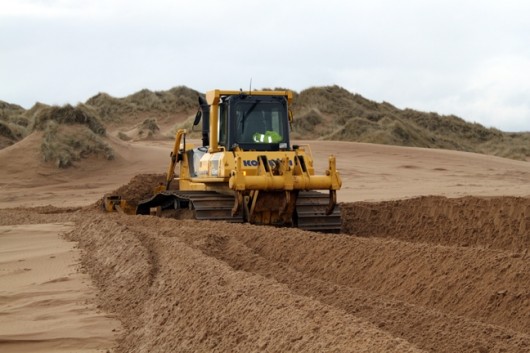 A bulldozer flattens out coastal sand dunes to make way for Donald Trump’s golf course
Aberdeenshire, Scotland A bulldozer flattens out coastal sand dunes to make way for Donald Trump’s golf course
Aberdeenshire, Scotland
.
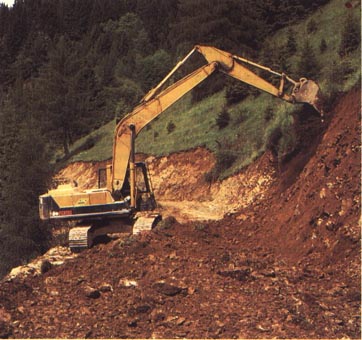 Dozer clearing the way Dozer clearing the way
.
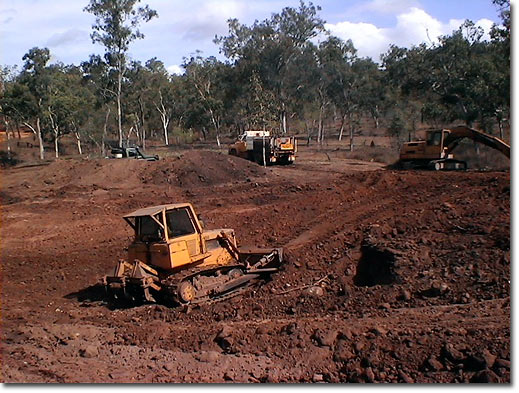 Dozers in Rosella Waters, doing it for permaculture in the Atherton Rainforest
(The Permaculture Research Institute on the USA)
…they wouldn’t let us back home Dozers in Rosella Waters, doing it for permaculture in the Atherton Rainforest
(The Permaculture Research Institute on the USA)
…they wouldn’t let us back home
.
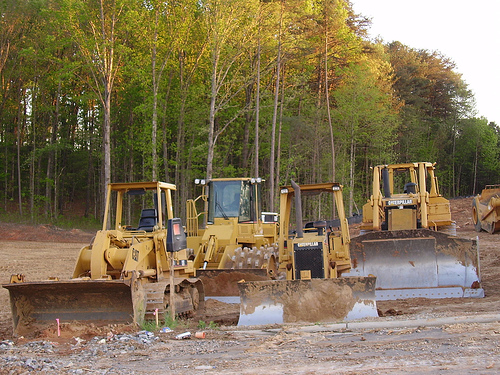 Smoko Smoko
.
 Dozers helping out for new housing in Brazil Dozers helping out for new housing in Brazil
.
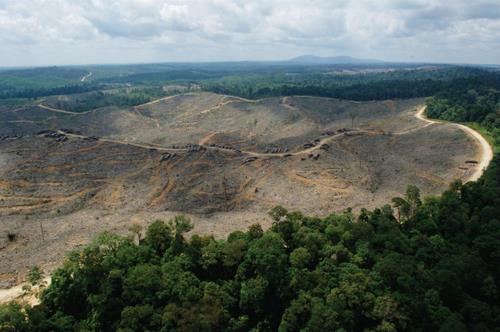 Dozers helping out in Sumatra for pulp wood
. Dozers helping out in Sumatra for pulp wood
.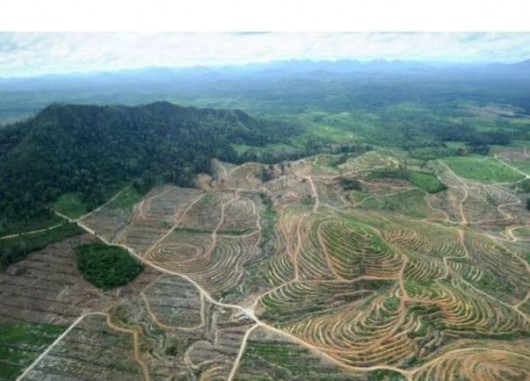 Dozers helping out for Palm Oil Dozers helping out for Palm Oil
.
 Dozer respect for riparian habitat Dozer respect for riparian habitat
.
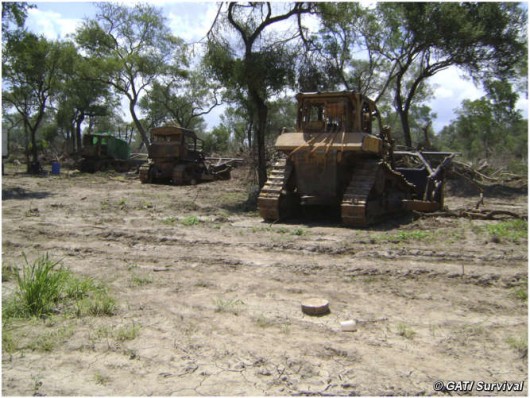 Dozers having a wee afternoon doze
. Dozers having a wee afternoon doze
.
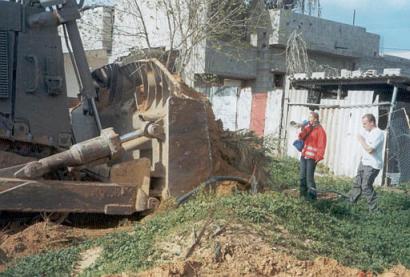 23 year old International Solidarity Movement activist Rachel Corrie
— about to be crushed by an Israeli bulldozer 20030317 23 year old International Solidarity Movement activist Rachel Corrie
— about to be crushed by an Israeli bulldozer 20030317
.
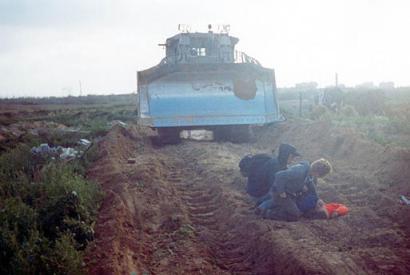 Greg Schnabel, 28, from Chicago, said the protesters were in the house of Dr. Samir Masri. Greg Schnabel, 28, from Chicago, said the protesters were in the house of Dr. Samir Masri.
“Rachel was alone in front of the house as we were trying to get them to stop,” he said. “She waved for the bulldozer to stop and waved. She fell down and the bulldozer kept going. We yelled ‘stop, stop,’ and the bulldozer didn’t stop at all. It had completely run over her and then it reversed and ran back over her.”
-from Ha’aretz
^http://www.indybay.org/newsitems/2003/03/17/15838231.php
.
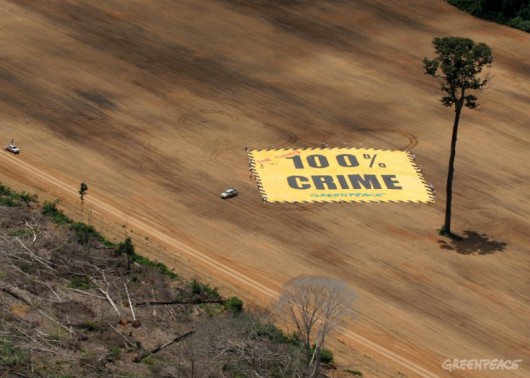 See, they just don’t understand See, they just don’t understand
.
Postcript:
.
We added the Israeli human tragedy to this article afterwards.
We were shocked and consider this event of 2003 murderously barbaric, and so not to be forgotten to history.
We include it to convey a message of comparison to readers that the unacceptable horror inflicted by humans on non-humans is comparable to the unacceptable horror humans continue to inflict upon themselves.
When one reflects about ‘humanity’ one considers the status well below ‘ecology’. Such distinguishing sadistic human motives are not part of non-human ecology.
.
What is CRIME?
.
Clearly current definitions of crime – its prevention, policing and presecution are inadequate…human and non-human.
It is when the human injustice hits home, that when compared with non-human injustice one starts to realise that injustice should not be selective.
.
Read About the ‘International Solidarity Movement‘
.
^http://en.wikipedia.org/wiki/International_Solidarity_Movement
.
Tuesday, February 28th, 2012
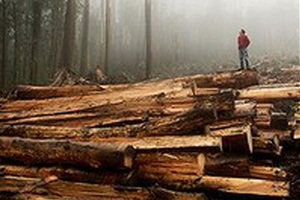  Click above icon to play Pink Floyd’s ‘Wish You Were Here’
..first turn speakers on, then while playing scroll slowly through this article… Click above icon to play Pink Floyd’s ‘Wish You Were Here’
..first turn speakers on, then while playing scroll slowly through this article…
.
..So, so you think you can tell
Heaven from Hell?
Blue skies from pain?
.
Can you tell a green field
From a cold steel rail?
A smile from a veil?
Do you think you can tell?
.
Did they get you to trade
Your heroes for ghosts?
Hot ashes for trees?
Hot air for a cool breeze?
.
Cold comfortable change?
Did you exchange
A walk on part in the war
For a lead role in a cage? …
.
(Lyrics extract from Pink Floyd’s legendary song ‘Wish You Were Here‘ off their 1975 album of the same name)
.
These photos, as you scroll through them, are of Tasmania’s wild old growth forest heritage, which is currently being destroyed in 2012, driven by the Premier Lara Giddings Labor Government of Tasmania.
.
.
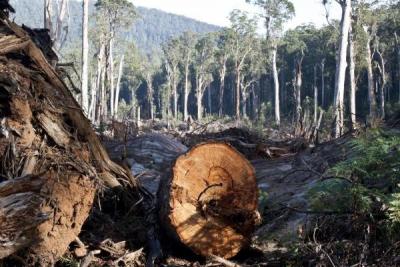 . .
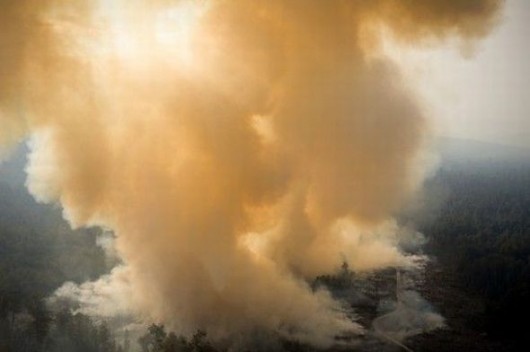 . .
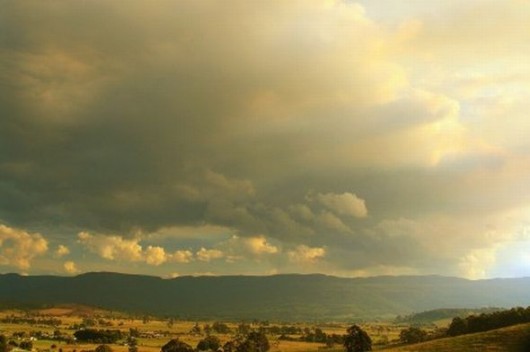 . .
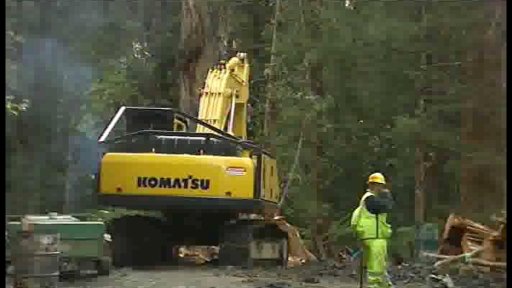 . .
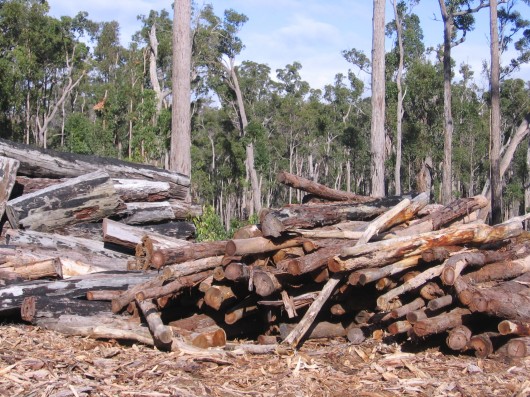 . .
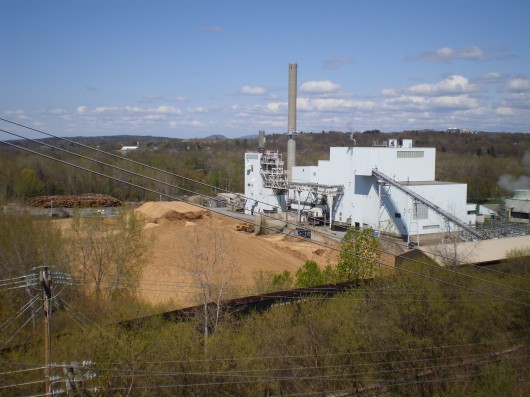 . .
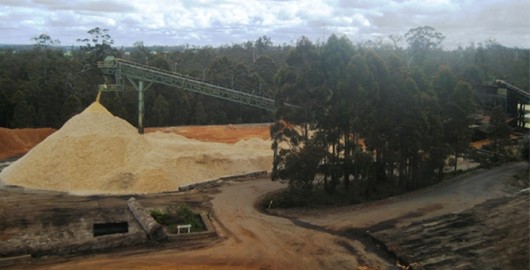 . .
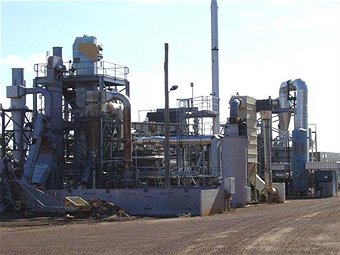 . .
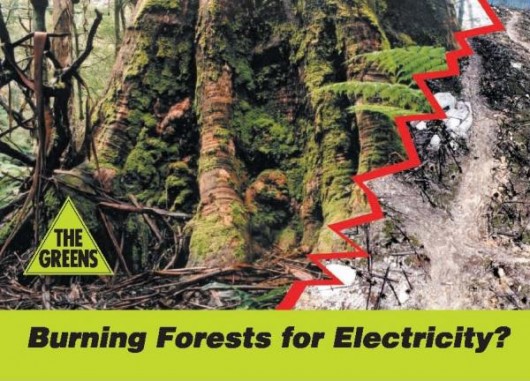 . .
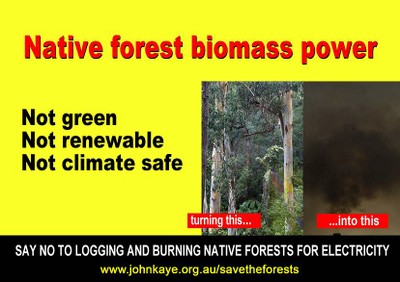 . .
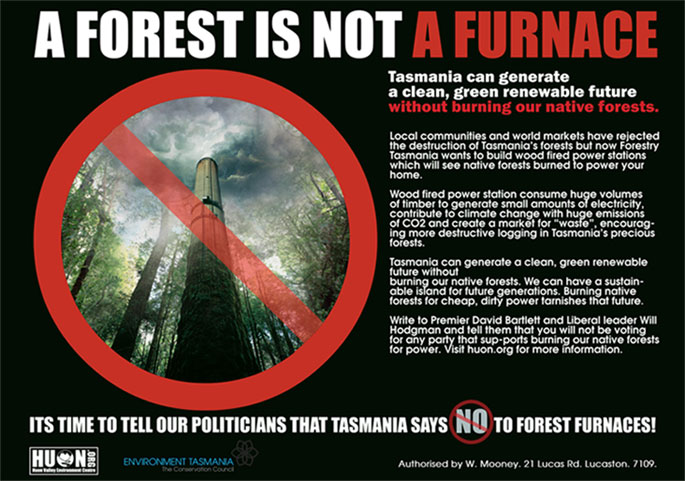 . .
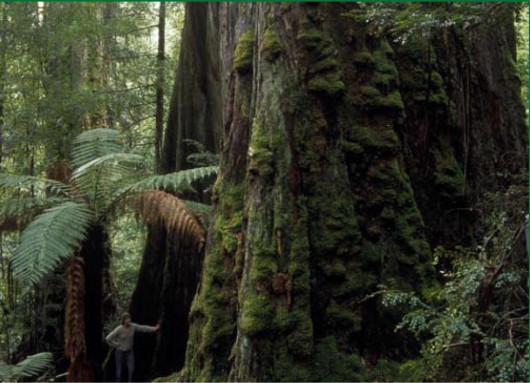 . .
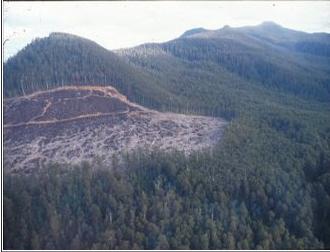 . .
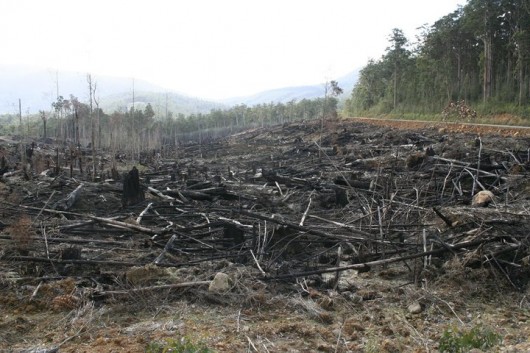 . .
 Australia’s Prime Minister Julia Gillard,
who on 7th August 2011 personally promised the protection of Tasmania’s old growth forests. Australia’s Prime Minister Julia Gillard,
who on 7th August 2011 personally promised the protection of Tasmania’s old growth forests.
.
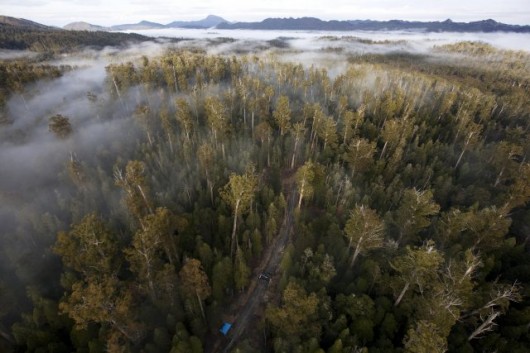 . .
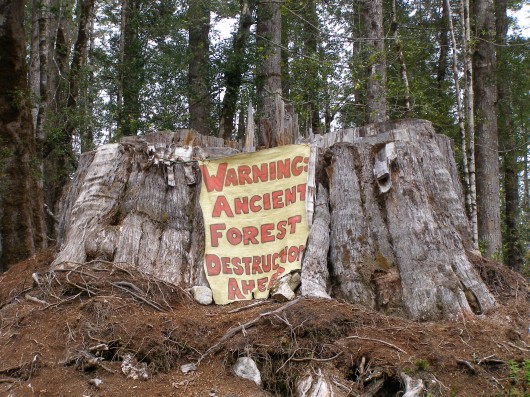 . .
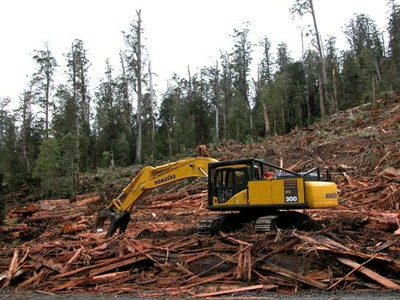 . .
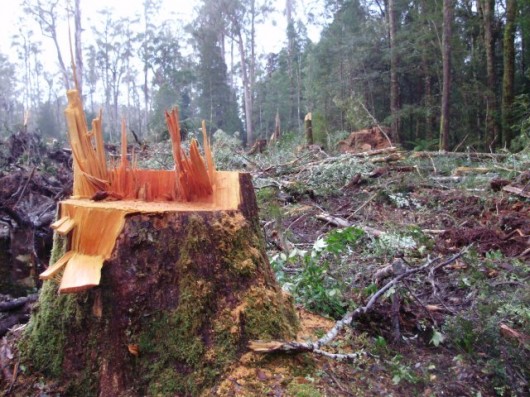 . .
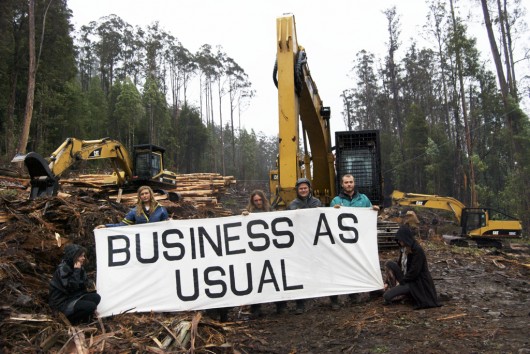 Click photo to enlarge Click photo to enlarge
.
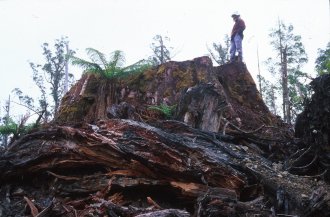 . .
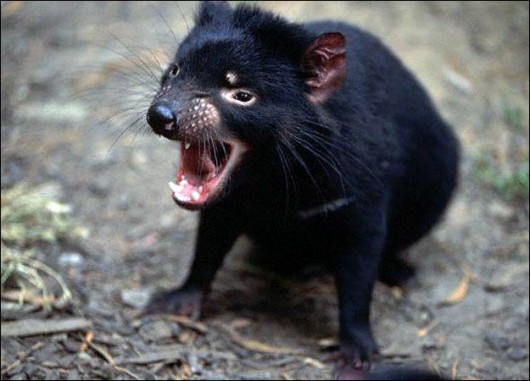
Tasmania’s disappearing wildlife wish Julia was here
.
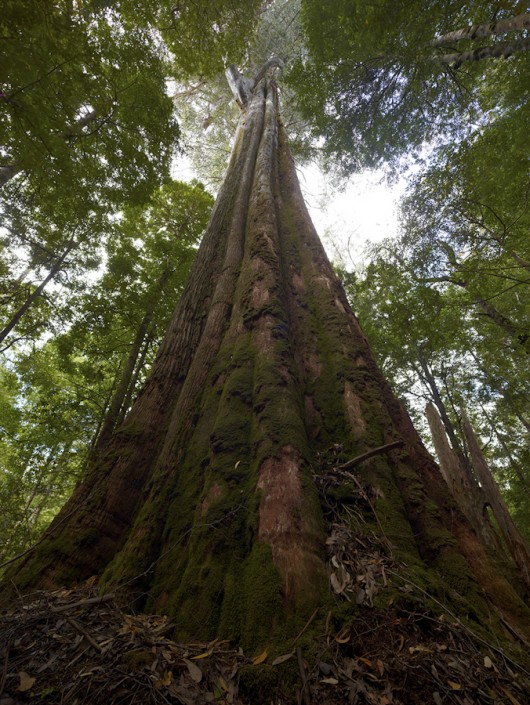 . .
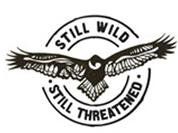 . .
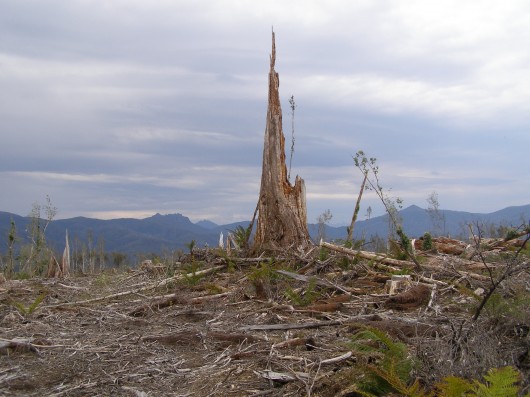 [Photo by Editor Sept 2011] [Photo by Editor Sept 2011]
Click photo to enlarge
.
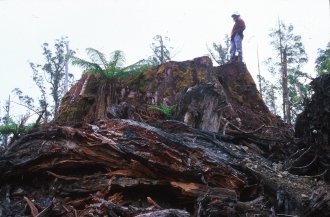 . .
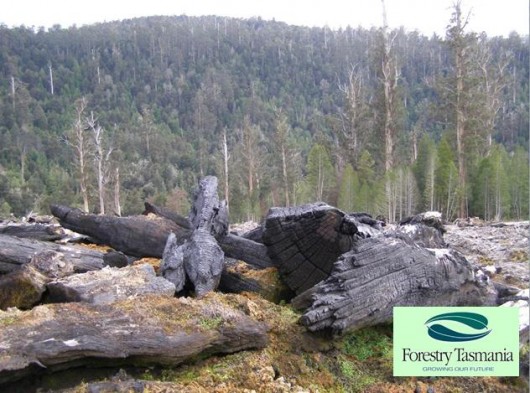 .. ..
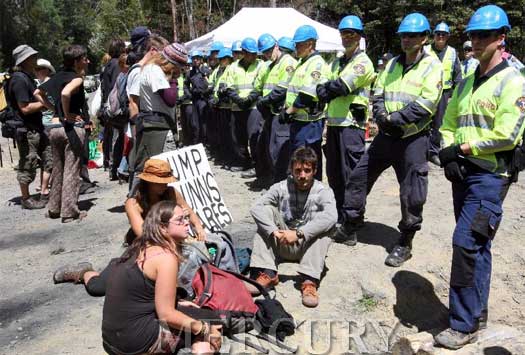 .. ..
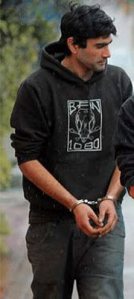
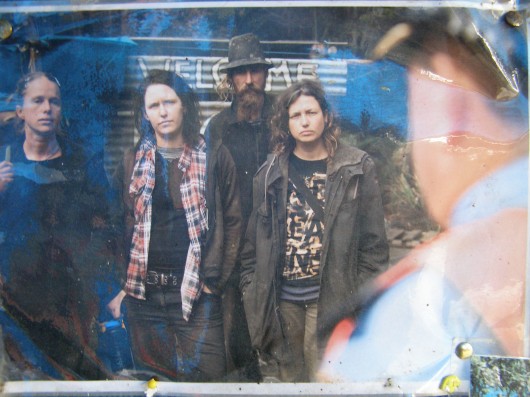 . .
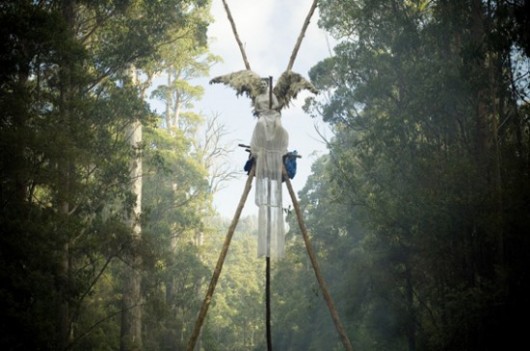 . .
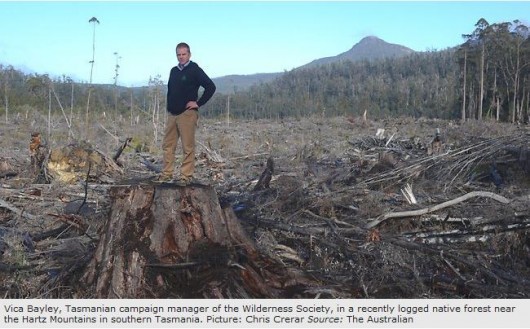 . .
 . .
 . .
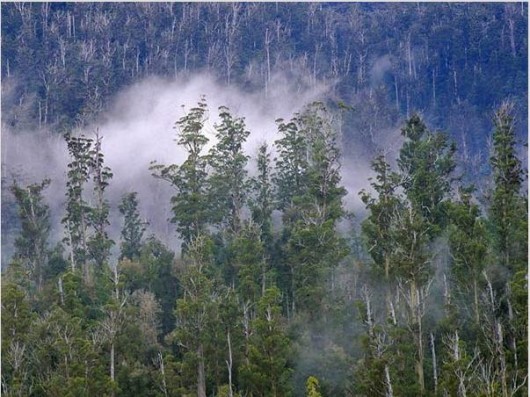 . .
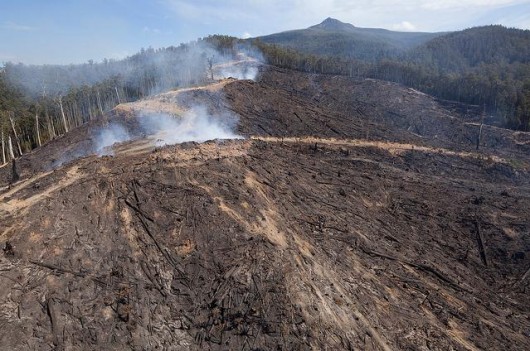 . .
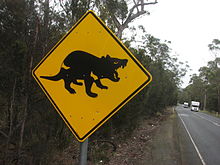 . .
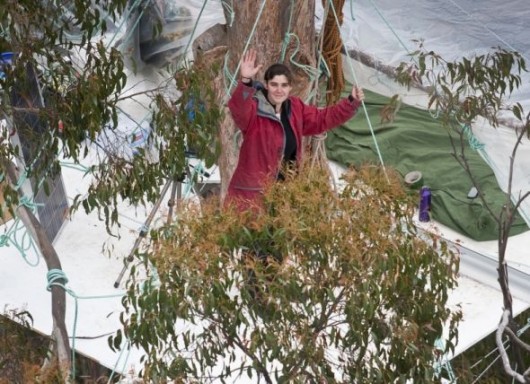 Follow the Tree Sit Protest defending Tasmania’s native forests
^http://observertree.org/ Follow the Tree Sit Protest defending Tasmania’s native forests
^http://observertree.org/
.
.
Friday, February 24th, 2012
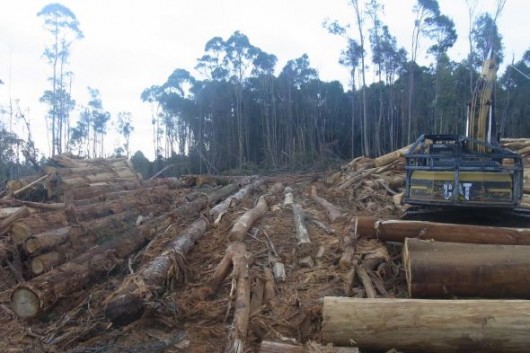 Tasmania’s Old Growth Forests
– victims of obsessive compulsive logging by Forestry Tasmania
(Photo courtesy of HVEC and Code Green) Tasmania’s Old Growth Forests
– victims of obsessive compulsive logging by Forestry Tasmania
(Photo courtesy of HVEC and Code Green)
.
Logging is not about woodchips or timber or even land clearing for plantations. It is a compulsive addiction, like compulsive hoarding.

Compulsive Logging Self Test:
Are you a compulsive logger? Answer YES or NO to the following:
.
- Do you find yourself logging forests that timber markets do not consider valuable?
- Do you experience difficulty or find it impossible to stop logging say for more than a week?
- Do you keep your chainsaw in your ute?
- When you drive past a forest, or even a tree for that matter, do you get an urge to chainsaw it?
- Do you need to be told to stop chainsawing at the end of a day’s shift, even after it has become dark?
- Do you have recurring dreams about falling trees?
- Do you hate Monty Python’s I’m a Lumberkjack song, and become agitated and violent when hearing it played?
.
If you answered YES to most of the above questions, you maybe a compulsive logger.
.
Forestry Tasmania a Compulsive Logger
.
Despite Tasmania’s Inter-governmental Agreement (IGA) on 7th August 2011 assuring immediate logging moratorium of native forests in agreed reserves, Forestry Tasmania continues to eco-rape and pillage protected native forests in defiance of this agreement.
.
IGA Clause 25 states:
‘The State will immediately place the 430,000 hectares of native forest identified in Attachment A (other than any areas that are not State forest), from the 572,000 hectares nominated by ENGOs through the Statement of Principles process, into Informal Reserves. The boundaries of this 430,000 hectares were verified through an independent verification process.’
.
Yet the Tasmanian Government’s industrial logger Forestry Tasmania displays business as usual pre-IGA (7-Aug-2011) and pre-Conservation Agreement (13-Jan-2012).
Forestry Tasmania is delinquent, operating to its own parallel agenda, despite being taxpaper funded, despite annually losing millions of taxpayer funding. It is an indulgent selfish cult offering only hand to mouth welfare to its logging members. It is currently getting stuck into Coupe BA388D in the Liffey State Forest inside the IGA Immediate Protection Area of 430,000 hectares.
.
Forestry Tasmania is characterised by the following:
-
- Feelings of excessive doubt and caution
- Preoccupation with details, rules, lists, order, organization or schedule
- Excessive conscientiousness, scrupulousness, and undue preoccupation with productivity to the exclusion of pleasure and interpersonal relationships
- Excessive pedantry and adherence to social conventions
- Rigidity and stubbornness
- Unreasonable insistence that others submit exactly to its way of doing things, or unreasonable reluctance to allow others to do things
- Intrusion of insistent and unwelcome thoughts or impulses.
Tasmanian Forests Minister Bryan Green dodges questions, covering for Forestry Tasmania
.
‘The Tasmanian Greens today accused the Minister for Forests Bryan Green MP of dodging questions on whether Forestry Tasmania has entered into any new wood supply contracts since the implementation of the moratorium on logging high conservation value forests.
Greens Forestry spokesperson Kim Booth MP said that in Parliament today the Minister would only say that Forestry Tasmania had renewed contracts with sawmills, but did not clarify whether the duration and/or volume of those contracts had been changed.
“I have asked Minister Green on numerous occasions to provide details of any contracts Forestry Tasmania has signed for logging or roading in high conservation value forests placed under a moratorium by the Forest Principles process,” Mr Booth said.
“Judging by the Minister’s refusal to answer my clear and direct question it would appear he is trying to cover for Forestry Tasmania’s refusal to comply with the IGA.”
“The Minister must clarify whether Forestry Tasmania is deliberately undermining the Tasmanian Forests Intergovernmental Agreement and all the hard work that has gone into it.”
“Forestry Tasmania is stuck in the past and continues to want to wage war over the Tasmanian forests by targeting areas of High Conservation Value forests.”
“The Minister for Forests must once and for all clarify what he knows about any contracts that have been signed or renewed since the moratorium was put in place.”
“I will be writing to the Minister for a full and detailed response to the question that I asked in Parliament today and I would urge him to encourage Forestry Tasmania to keep up with the expectations of Tasmanians and play their part in the implementation of the IGA.”
November 16, 2011
[Source: ^http://mps.tas.greens.org.au/2011/11/minister-dodges-questions-covering-for-forestry-tasmania/]
.
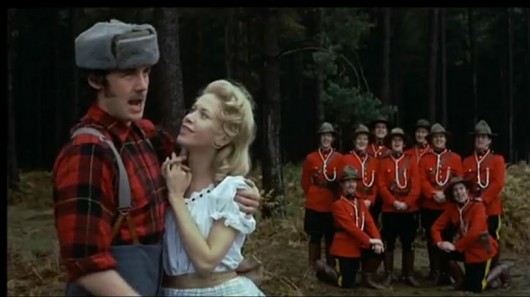

.
I’m a Lumberjack
(Tasmanian version)
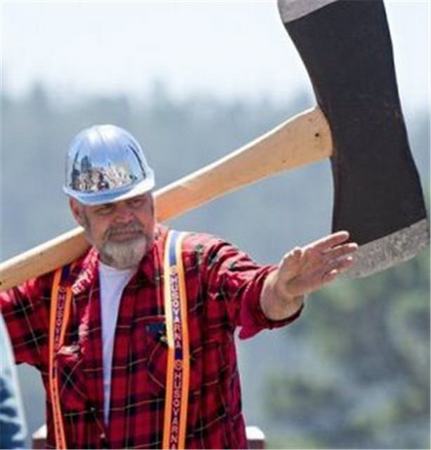
He’s a logger and he’s okay, he borrows for gear ‘cos Gillard ‘ll pay.
.
FORESTRY TAS:
He’s a logger, and he’s okay.
He borrows for gear cos Gillard will pay.
.
LOGGER:
I cut down trees. I eat my lunch.
I go to the lavatory.
On Fridays afters, I knock off
And call into the National for tea.
.
FORESTRY TAS:
He cuts down trees. He eats his lunch.
He goes to the lavatory.
On Fridays afters, I knock off
And call into the National for tea.
He’s a logger, and he’s okay.
He sleeps all night and he works all day.
.
LOGGER:
I cut down trees. I skip and jump.
I like to press wild flowers.
I put on women’s clothing
And hang around in bars.
.
FORESTRY TAS:
He cuts down trees. He skips and jumps.
He likes to press wild flowers.
He puts on women’s clothing
And hangs around in bars?!
He’s a lumberjack, and he’s okay.
He sleeps all night and he works all day.
.
LOGGER:
I cut down trees. I wear high heels,
Suspendies, and a bra.
I wish I’d been a girlie,
Just like my dear Papa.
.
FORESTRY TAS:
He cuts down trees. He wears high heels,
Suspendies, and a bra?!
?????
What’s this? Wants to be a girlie?! Oh, My!
…X%$*&#@)*#!^@!
He’s a lumberjack, and he’s okay.
He sleeps all night and he works all day.
He’s a lumberjack, and he’s okaaaaay.
He sleeps all night and he works all day.
.
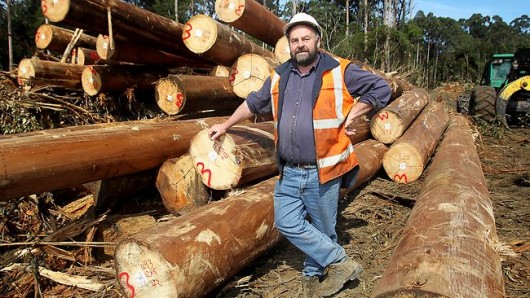 . .
‘An audit of Forestry Tasmania’s logging plans by environment groups shows Forestry Tasmania has not only failed to cease logging within proposed new forest reserves, but since receiving a $12.5 million government payout, it has increased the number of logging operations within the new reserve areas — a move directly at odds with the Tasmanian Forests Intergovernmental Agreement (IGA).’
~ 9th February 2012
.
[Source: ‘Forestry Tasmania’s ongoing logging in proposed new forest reserves‘, joint publication by The Wilderness Society, Environment Tasmania, and the Australian Conservation Foundation, ^http://www.wilderness.org.au/pdf/ongoing-logging-report >Read Report (pdf) ]
.
Tuesday, February 21st, 2012
This article was initially published on 20110728 by the UK based Environmental Investigation Agency (EIA) under its press release entitled ‘Vietnamese Army named as timber smuggler’, Contact: EIA, 62-63 Upper Street, London N1 0NY, United Kingdom, ^www.eia-international.org]
.
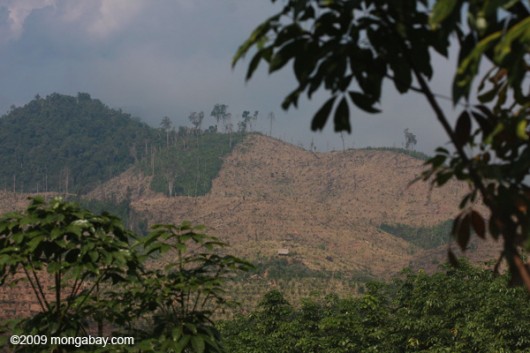 Forests in Laos have declined steadily in recent decades,
falling from 64% cover in 1960 to 41% in 2005.
Primary forests now cover less than 10 % of the country according to U.N. data.
(Source: Mongabay, ^http://news.mongabay.com/2011/0622-laos_crackdown.html) Forests in Laos have declined steadily in recent decades,
falling from 64% cover in 1960 to 41% in 2005.
Primary forests now cover less than 10 % of the country according to U.N. data.
(Source: Mongabay, ^http://news.mongabay.com/2011/0622-laos_crackdown.html)
.
BANGKOK: A new report released today (20110728) exposes the pivotal role played by the Vietnamese military in a multi-million dollar operation which is smuggling threatened timber over the border from the shrinking forests of neighbouring Laos.
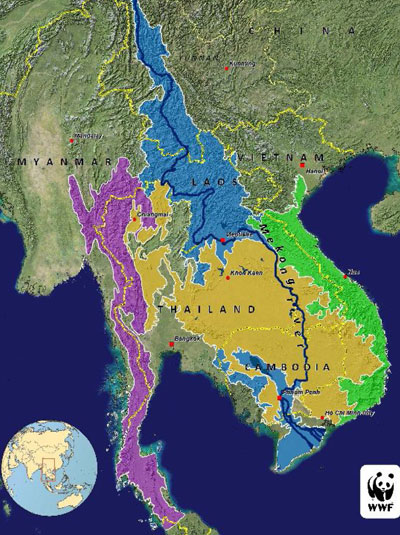 Greater Mekong Region Greater Mekong Region
.
Laos has some of the Mekong region’s last intact tropical forests, but the London-based Environmental Investigation Agency (EIA) report Crossroads: The Illicit Timber Trade Between Laos and Vietnam reveals its export ban on raw timber is routinely flouted on a massive scale to feed the ravenous timber processing industries of Vietnam, China and Thailand.
During undercover operations in 2010 and 2011, EIA agents posing as timber buyers tracked a trail of corruption and inadequate enforcement back from the busy furniture factories and ports of Vietnam to its border with Laos and beyond.
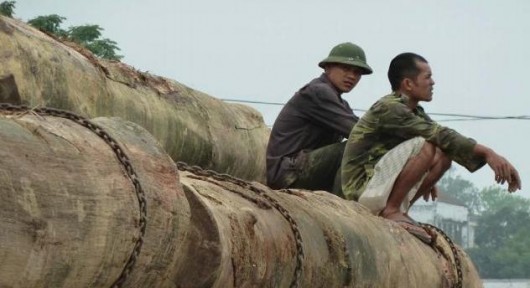 The forests of Laos support the livelihoods of millions of rural and indigenous people but are seriously threatened by over-exploitation; such is the volume of illegal timber flowing through Laos’ porous borders that its furniture manufacturing industry is finding it cannot supply orders due to a lack of raw materials. The forests of Laos support the livelihoods of millions of rural and indigenous people but are seriously threatened by over-exploitation; such is the volume of illegal timber flowing through Laos’ porous borders that its furniture manufacturing industry is finding it cannot supply orders due to a lack of raw materials.
Through investment in logging, plantations and hydropower projects, Vietnamese firms have appropriated large swathes of Lao forests, yet the only winners in Laos are corrupt Government officials and well-connected businessmen. Meanwhile, Vietnamese logging companies and furniture factories are booming on the back of the illegal trade, exporting billions of dollars worth of finished wood products to the major markets of the USA and European Union.
And EIA’s investigations revealed that one of the biggest loggers in Laos is a company owned by the Vietnamese military. Investigators first encountered the Vietnamese Company of Economic Cooperation (COECCO) in October 2010 during a visit to Qui Nhon port, documenting huge piles of logs bearing green paint marks and tagged with yellow labels bearing a Vietnamese name which translated into Company of Economic Cooperation – Ministry of Defence (or COECCO). A port worker said 95 per cent of the logs had come from
Laos and most were owned by the Vietnamese military; specifically Military Zone 4.
Similarly marked logs were observed in a huge storage area between the two formal checkpoints at the Bo Y border crossing (‘F‘ on map below) and EIA was eventually able to confirm that most of them had come from logging operations linked to the construction of a nearby hydropower dam.
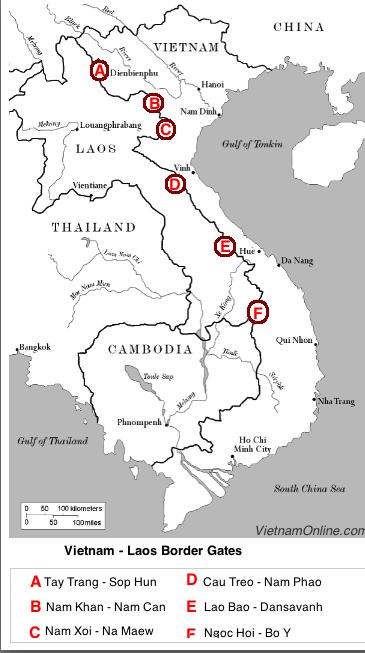
To uncover more details of the company’s operations, EIA investigators travelled to COECCO’s headquarters in Vinh City, Vietnam, in May 2011 and learnt COECCO has been in the timber trade and logging business in Laos for more than 20 years, that it sources most of its logs from Lao dam clearance sites and that it is one of a handful of companies permitted to carry out logging in these areas.
A well-connected Lao company is also making a fortune trading logs to Vietnam; the Phonesack Group, the boss of which is connected with the Lao Government, prefers to send logs across the border while its own wood processing struggles to get supplies of raw material.
EIA Head of Forest Campaign Faith Doherty said:
“EIA first exposed the illicit log trade between Laos and Vietnam in 2008, and our latest investigations reveal that sadly nothing has changed.
“The governments of Vietnam and Laos urgently need to work together to stem the flow of logs and curb the over-exploitation of Laos’ precious forests before it’s too late, and the Vietnamese military must be excluded from logging operations in Laos. “With a new Timber Regulation coming into force within European markets in 2013, both Vietnam and Laos have a lot at stake and urgently need to work with the European Union.”
.
Urgent Call to Action – by EIA
.
1. THE GOVERNMENT OF LAOS SHOULD:
- Enforce its log export ban
- Publish details of all logging quotas and the selection process
- Clarify rules for converting forest land for plantations
.
2. THE GOVERNMENT OF VIETNAM SHOULD:
- Respect the policies of the Lao Government by blocking log imports from the country
- Hold bilateral talks with the Government of Laos over illicit wood trade between the two countries
- Work with Vietnamese wood industry associations to exclude Lao logs from its supply chain
- Exclude military businesses from carrying out logging operations in Laos
.
3. THE EUROPEAN UNION SHOULD:
- Ensure that any Voluntary Partnership Agreement (VPA) discussions with Vietnam and Laos address the issue of log trade between the two countries
- Ensure that VPA talks include the full range of stakeholders
- Promote forest governance lessons from FLEGT (Forest Law Enforcement, Governance and Trade) into the development of REDD+ (Reducing Emissions from Deforestation and Forest Degradation) , specifically in terms of displaced deforestation
.
4. COMPANIES AND CONSUMERS SHOULD:
- Obtain proof that wood products sourced from Vietnam are not derived from logs imported from Laos
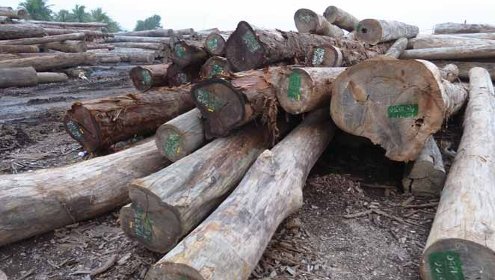
Copies of the full Crossroads report, stills and footage are available on request from Environmental Investigation Agency (EIA) Press Officer Paul Newman at paulnewman@eia-international.org, or or Faith Doherty at faithdoherty@eia-international.org.
.
Illegal logging and the associated trade in stolen timber
.
[Source: ‘Transnational Organised Crime in South East Asia: Threat Assessment‘, article in newsletter ‘NTS Alert’, July 2010 (Issue 1), published by the Centre for Non-traditional Security Studies (NTS), within the S. Rajaratnam School of International Studies (RSIS), Graduate School of Nanyang Technological University, Singapore, ^http://www.rsis.edu.sg/nts/HTML-Newsletter/alert/NTS-alert-jul-1001.html]
.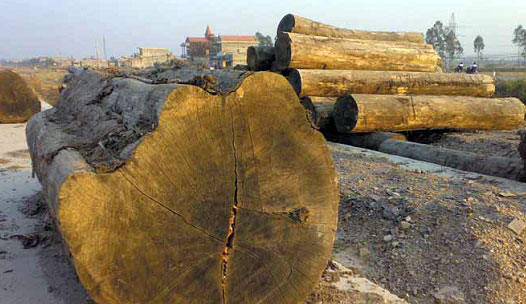 Yellow balau log from Lao Peoples Democratic Republic, awaiting transportation. Yellow balau log from Lao Peoples Democratic Republic, awaiting transportation.
(Photo : Environmental Investigation Agency, 2008)
.
Illegal logging occurs when timber is harvested, transported, processed, bought, or sold in violation or circumvention of national or sub-national laws (Miller et al., 2006). Between 8 and 10 per cent of global wood products stems from illegal logging, with annual global market value of losses estimated at over USD 10 billion (United Nations Office on Drugs and Crime – UNODC, June 2010). Southeast Asia is a major supplier of illicit timber with an estimated annual turnover of USD 3.5 billion. As much as 40 per cent of wood-based products imported into the EU in 2008 and half of China’s imports in 2007 (worth USD 900 million) originated from illegal logging.
Indonesia remains the country most heavily affected by illegal logging. The country possesses 123 million ha of forest (10 per cent of global forest cover) including the third largest tropical rainforest. As much as 80 per cent of timber logged in Indonesia is suspected to be illegally sourced with annual losses in government revenue estimated at USD 2 billion (Human Rights Watch, 2009). The Indonesian Ministry of Forestry estimates that in recent years, the country lost between 1.6 and 2.8 million ha of forest annually (between 3 and 5 ha a minute) to illegal logging and land conversion (UNODC, June 2010).
.
Imported Rainforest Timbers to Australia
[Source: ‘The Good Wood Guide: A Residents Guide to Purchasing Environmentally Friendly Timber’, Waverley Council, NSW, ^http://www.wettropics.gov.au/st/rainforest_explorer/Resources/Documents/8to9/GoodWoodGuide.pdf]
.
About 13% of Australia’s sawn timber is sourced from tropical forests. We also import tropical rainforest timber items such as veneers, plywoods and picture mouldings. The majority of these timber products are sourced from unsustainably logged forests and could be replaced by sustainable locally grown alternatives.
Logging tropical rainforests causes the extinction of hundreds of plant and animal species each year in addition to loss of the home of many indigenous tribal peoples. In South East Asian rainforests the rate of clearing is five million hectares per year. Once an intact rainforest has been destroyed, it cannot be replaced for thousands of years.
Ed: A rainforest is not a ‘renewable resource’. Rainforest timber is driving extinctions.
.
Commonly Imported South East Asian Rainforest Timbers to Avoid
.
- Meranti
- Merbau
- Ramin
- Pacific Maple
- Philippine Mahogany (Calantas)
- Keruing (also known as Naytoh, Narra and Kapur)
- Teak
- Jelutong
- Motoa (also known as Merawan, Batu)
- Balau
.
Old-Growth Forests
.
‘Old-growth forests are native forests which have had no recent disturbance by humans and regenerate naturally over hundreds of years. Like rainforest, old growth forests provide vital habitats for many species of flora and fauna. These forests are becoming increasingly rare both overseas and in Australia. Consequently we recommend that you avoid timbers sourced from old growth forests.’
Chea Sa Timber wholesales SE Asian rainforest timbers

…’We are a well established trading company situated in Malaysia. We have been in this industry since year 1995 and have earned superb reputation in our business circle. We offer a large variety of Tropical sawn timber. We have excellent sources and reliable network to fulfill both local and international market. ‘Currently, our overseas customers including Singapore, Hong Kong, China, Japan & etc. We intend to further expand our business to new markets abroad and looking for long term business partners worldwide.
Products
We specialize in following sawn timber, size in accordance to customer’s requirement:
- Finger Jointed Wood (Meranti, Durian, Sesendok)
- Meranti (Light Red/Dark Red)
- Kapur
- Kempas
- Keruing
- Merbau
- Merbatu
- KSK (Kembang Semangkok, or ‘Samrong’)
- Yellow Balau (Selangan Batu) & etc
.
[Source: ^http://www.cheasatimber.com/index.html]
.
‘Serano Timber’ in Dandenong Victoria retails Yellow Belau’
.

 Source: ^http://www.seranotimber.com.au/yellow-balau.html
Source: ^http://www.seranotimber.com.au/yellow-balau.html
.
Further Reading:
.
[1] FLEGT (Forest Law Enforcement, Governance and Trade), ^ http://www.euflegt.efi.int/portal/ ‘The Forest Law Enforcement, Governance and Trade (FLEGT) Action Plan sets out a range of measures available to the European Union and its Member States to tackle illegal logging in the world’s forests. Use the menu on the left to find more information about the FLEGT programme.’
.
[2] UN-REDD (Reducing Emissions from Deforestation and Forest Degradation), ^ http://www.un-redd.org/ ‘ The UN-REDD Programme is the United Nations Collaborative initiative on Reducing Emissions from Deforestation and forest Degradation (REDD) in developing countries. The Programme was launched in September 2008 to assist developing countries prepare and implement national REDD+ strategies, and builds on the convening power and expertise of the Food and Agriculture Organization of the United Nations (FAO), the United Nations Development Programme (UNDP) and the United Nations Environment Programme (UNEP).’
.
[3] Illegal Logging (UK-based) website, ^ http://www.illegal-logging.info/index.php , ‘ The purpose of this site is to provide information on the key issues in the debate around illegal logging and the trade in illegal timber, via news stories and key documents, as well as details of relevant events, and links to other relevant websites.’
.
Tags: Balau, Bo Y border crossing, Greater Mekong Region, illegal logging, Illicit Timber Trade, Lao Government, Laos, Phonesack Group, rainforest timber, Vietnamese Army, Vietnamese Company of Economic Cooperation, Voluntary Partnership Agreement
Posted in Mekong (VN), Threats from Deforestation | No Comments »
Add this post to Del.icio.us - Digg
|
|
 Click this image to play music
then click back to this article as it plays
Click this image to play music
then click back to this article as it plays Nothing less than the Australian Government can be trusted to protect vital Koala Habitat.
Lesser smaller-minded state governments only see Koala Habitat as a logging and tourism resource.
Small minded politicians like Kristina Keneally can never be trusted with national treasures
Nothing less than the Australian Government can be trusted to protect vital Koala Habitat.
Lesser smaller-minded state governments only see Koala Habitat as a logging and tourism resource.
Small minded politicians like Kristina Keneally can never be trusted with national treasures
 Bermagui’s Spotted Gums
..the local Narooma Community in their defence against ‘Forest NSW’ (the Forest-Fiddling loggers)
Bermagui’s Spotted Gums
..the local Narooma Community in their defence against ‘Forest NSW’ (the Forest-Fiddling loggers)
 Forest-Fiddling Logger driving his Spotted Gum spoils truck
Forest-Fiddling Logger driving his Spotted Gum spoils truck
 But Eucalyptus maculata is a tree, not a floor
But Eucalyptus maculata is a tree, not a floor Spotted Gum bark
Spotted Gum bark
 Build something great, but don’t destroy something great in the process
– like Koala Spotted Gum Forests!
Invest in Boral and you invest in Koala extinction
Build something great, but don’t destroy something great in the process
– like Koala Spotted Gum Forests!
Invest in Boral and you invest in Koala extinction
 Koala in Bermagui’s Spotted Gum forest – a displaced landlord
Koala in Bermagui’s Spotted Gum forest – a displaced landlord A mature iconic Spotted Gum Tree
About 400 years old, about 30 metres high
A mature iconic Spotted Gum Tree
About 400 years old, about 30 metres high Note the planet’s sole natural distribution of Spotted Gum Forests
They have become the target of corporate development simply because Spotted Gums prefer a mild temperate climate near the coast
..like Australia’s millions of breeding humans, and profiteering corporate developers
Note the planet’s sole natural distribution of Spotted Gum Forests
They have become the target of corporate development simply because Spotted Gums prefer a mild temperate climate near the coast
..like Australia’s millions of breeding humans, and profiteering corporate developers Grey-Headed Flying Fox (Pteropus poliocephalus)
The grey-headed flying-fox is listed as vulnerable to extinction under NSW and Australian legislation because of declining numbers and key threats such as habitat loss and urban conflict. Records indicate that grey-headed flying-foxes may once have numbered in the millions, but are now reduced to as few as 400,000. In the decade before listing, their population was estimated to have declined by 30%.
(Photo by Ákos Lumnitzer, ^http://amatteroflight.com/)
Grey-Headed Flying Fox (Pteropus poliocephalus)
The grey-headed flying-fox is listed as vulnerable to extinction under NSW and Australian legislation because of declining numbers and key threats such as habitat loss and urban conflict. Records indicate that grey-headed flying-foxes may once have numbered in the millions, but are now reduced to as few as 400,000. In the decade before listing, their population was estimated to have declined by 30%.
(Photo by Ákos Lumnitzer, ^http://amatteroflight.com/)
 Bermagui State Forest after the loggers
Bermagui State Forest after the loggers Kevin Mathie – 4th generation logger
Kevin Mathie – 4th generation logger
 Logging contractor, Gil Mathie, in the middle of the picture at front (pink jumper)
More notably, this editor is saddened by bearing witness to a senior member
of the Bermagui community being arrested for conserving Spotted Gums and Koalas.
We love, we defend, we act for love.
Salute the man being arrested.
[Source: Local environmentalist, John Perkins, Gulaga Protest near Tilba on the NSW South Coast, 20070514]
Logging contractor, Gil Mathie, in the middle of the picture at front (pink jumper)
More notably, this editor is saddened by bearing witness to a senior member
of the Bermagui community being arrested for conserving Spotted Gums and Koalas.
We love, we defend, we act for love.
Salute the man being arrested.
[Source: Local environmentalist, John Perkins, Gulaga Protest near Tilba on the NSW South Coast, 20070514]
 Labor’s Police Minister Tony Kelly MLC
NSW Minister for Emergency Services, Lands, Police and Primary Industries.
Labor’s Police Minister Tony Kelly MLC
NSW Minister for Emergency Services, Lands, Police and Primary Industries.
 Labor’s Logging Minister Ian MacDonald MLC
Forests NSW/ Minister for Primary Industries in 2009
Labor’s Logging Minister Ian MacDonald MLC
Forests NSW/ Minister for Primary Industries in 2009
 A community morally right to defend habitat and prepared to defend that right
A community morally right to defend habitat and prepared to defend that right
 Speeding logging trucker blames possum
..Narooma News editor’s reputation shot
Speeding logging trucker blames possum
..Narooma News editor’s reputation shot
 Narooma Community in defence of Koala Habitat
– clearly not convinced about Forests NSW spiel about “optimising the benefits to the community”
Narooma Community in defence of Koala Habitat
– clearly not convinced about Forests NSW spiel about “optimising the benefits to the community”
 Daishowa – Japan’s BIG Corporate Eco-Rapist and BIG Koala Exterminator
Daishowa – Japan’s BIG Corporate Eco-Rapist and BIG Koala Exterminator
 Boral Spotted Gum – corporate shareholder perspective
.
Boral Spotted Gum – corporate shareholder perspective
.
 Spotted Gums too magnificent to kill
[Source: Save Our Water Ways Now, photo by Robert Whyte,
^http://www.saveourwaterwaysnow.com.au/01_cms/details_pop.asp?ID=135]
Spotted Gums too magnificent to kill
[Source: Save Our Water Ways Now, photo by Robert Whyte,
^http://www.saveourwaterwaysnow.com.au/01_cms/details_pop.asp?ID=135]













 The classic image of the ‘Camp Fire’
The classic image of the ‘Camp Fire’


















































 Dozers having a wee afternoon doze
.
Dozers having a wee afternoon doze
.



































































